Create journey maps that drive sustainable customer-centric change.
Published in: Journey Mapping / Last update: August 2020
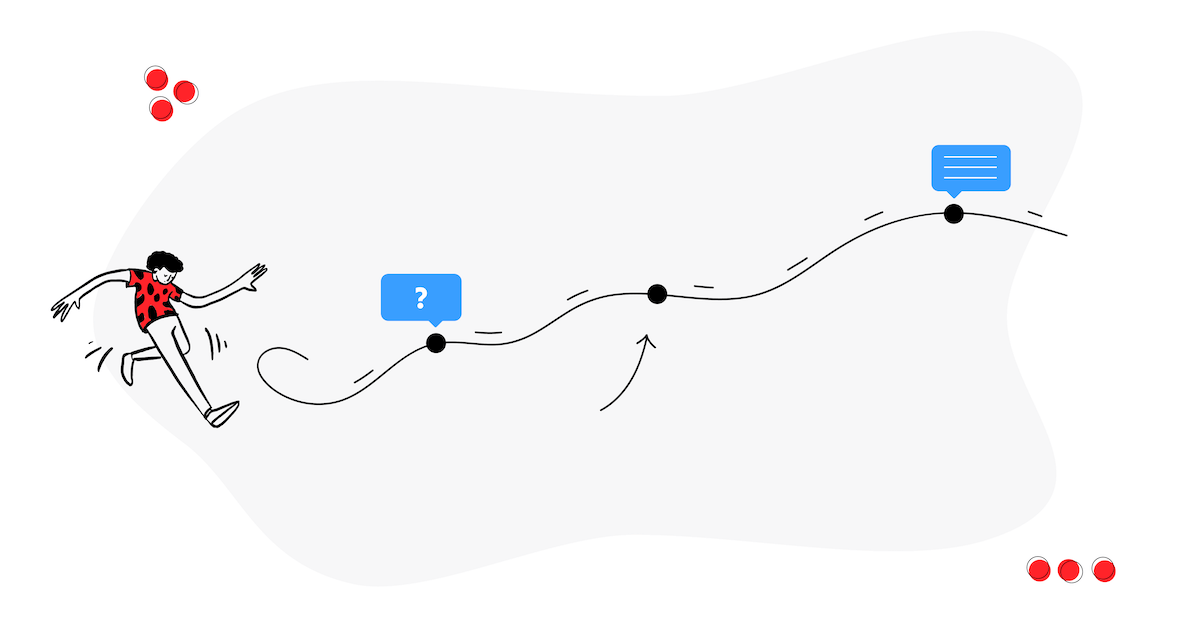
The goal of this guide is to help you create better customer journey maps in less time and with more confidence.
As the title says, this is a practical guide, which means that everything you're going to read is tailored toward helping you apply this knowledge in your work today.
This guide contains a lot of information, as I want to give you a holistic perspective on customer journey mapping rather than just a small piece of the puzzle like most other guides.
As you'll discover, the actual journey map is just a piece in this puzzle. By understanding the bigger picture, you can steer your efforts toward building an organization that’s customer centric on the long term, instead of a one-off journey map.
You can read this guide from top to bottom or use the Table of Contents to skip ahead to the topic that's most relevant to you.
And in case you're wondering, yes, this guide also applies to employee journeys, patient journeys, student journeys, etc. Because, even though the type of customer changes, most of the principles stay the same.
If you've got any questions based on this guide, I invite you to share them in the comments section at the end.
Introduction
Why a guide on customer journey mapping?
Over the last few years, customer journey maps and the process of customer journey mapping have gained a lot of attention. If you work in an organization where customer experience (CX) is on the management agenda, it's very likely that you've seen a journey map at least once or twice.
We have to celebrate that organizations are finally putting more focus on understanding the needs of their customers and building services that fulfil those needs.
And it's true that customer journey maps are of great value in this process, but only when they are created and used in the right way.
What got us here, won't get us there.
The practice of customer journey mapping has grown quite organically. It's not a formal or an accredited profession.
The early adopters have a strong DIY mentality. Just start mapping and figure out along the way how it should be done. What could go wrong, right!? 🙂
This approach works great when you have the space to experiment. We should thank these early pioneers for paving the path that we now walk on.
Scattered, Contradicting, and Superficial Information
By now, there's a lot of knowledge around customer journey mapping—what works and what doesn't.
But when you go searching for this information, it's scattered all over the place and often even provides you with contradicting views.
While the term customer journey is widely used, and customer journey approaches are commonly applied, there does not seem to be a common understanding of what customer journeys are and how different customer journey approaches may support service management and design.
Source: Customer journeys: a systematic literature review (PDF)
Also, the information you'll find in your search often covers just one aspect of journey mapping. One article talks about why journey maps matter, while another just gives you a simplified view of the process.
Too often, people who write about journey mapping have little practical experience. They might understand the theory but lack the scars from actually working with journey maps, which would enable them to give a more nuanced perspective.
You need to go beyond journey mapping 1.0
The strong visual nature of customer journey maps makes them appealing to a broad audience. Anyone who takes a glance at the map gets what they are about. This is both a curse and a blessing.
The problem is that most people don't go beyond the visual aspect of the map, which is a good-looking image used to get an overview. Let’s call this overview-only approach “customer journey mapping 1.0.”
Yes, maps are useful to get an overview, but that's not where the true value lies.
As you read further in this guide, you’ll see how these kinds of journey maps are usually a waste of time and effort. More often than not, they lead to disappointment rather than deliver results.
When your goal is to drive customer-centric change and innovation within your organization, you need to adopt a different approach toward journey maps.
You have to move away from the map as simply a pretty image on the wall.
You unlock the real power of journey maps when you use them to align the organization to deliver services that create value for both customers and the business.
Create professional maps in less time and with more confidence.
If you're still here, I guess you're interested in how to take your customer journey mapping skills to the next level. Great!
Throughout this guide, you'll get clear and consistent answers to some of the most common questions regarding customer journey mapping.
We're also going to get some of the big misconceptions out of the way and help you avoid common pitfalls.
After reading this guide, you'll understand what it takes to create professional journey maps in less time and with more confidence.
Ready? Here we go!
What is a customer journey map?
Let's start with the most obvious question: What is a customer journey map?!
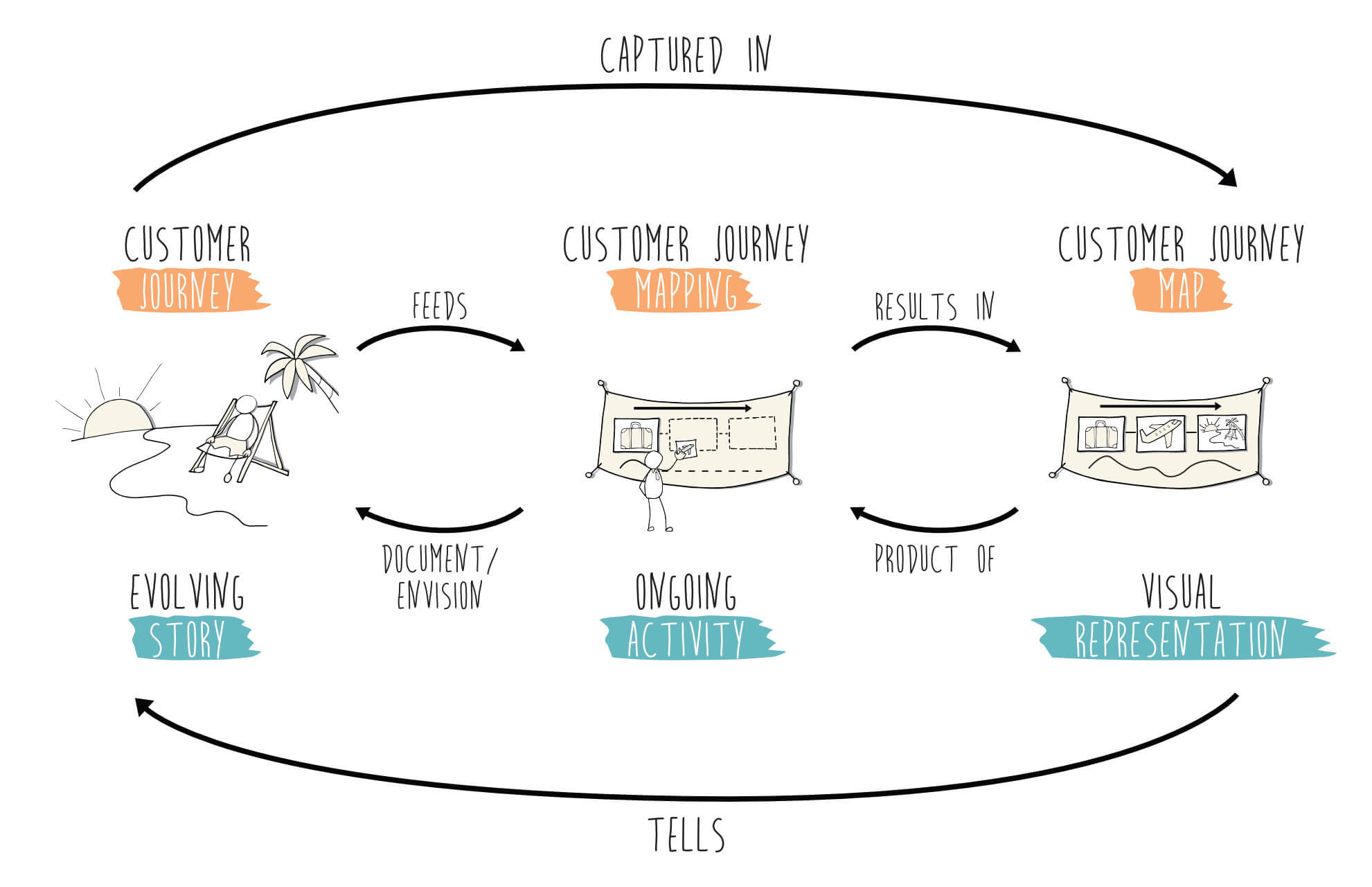
The term addresses the processual and experiential aspects of service processes as seen from the customer viewpoint. It is described as the repeated interactions between a service provider and the customer (Meroni and Sangiorgi, 2011), as an "engaging story" about the user's interaction with a service (Stickdorn and Schneider, 2010), or as a walk "in the customer's shoes" (Holmlid and Evenson, 2008).
Source: Customer journeys: a systematic literature review (PDF)
There seems to be a lot of variations to the definition. I'm not sure why, but some people give really complex and straight-out weird answers to this question.
I like to keep things simple, so here's my take:
A customer journey map is a visual representation of the activities and situations a customer goes through before, during, and after engaging with a service.
For sure, this one sentence doesn't tell the whole story about customer journey maps. But that's not the goal.
In this article you can learn more about the relationship between a customer journey map (the visual), customer journey mapping (the activity) and the customer journey (they story).
Why do organizations use customer journey maps?
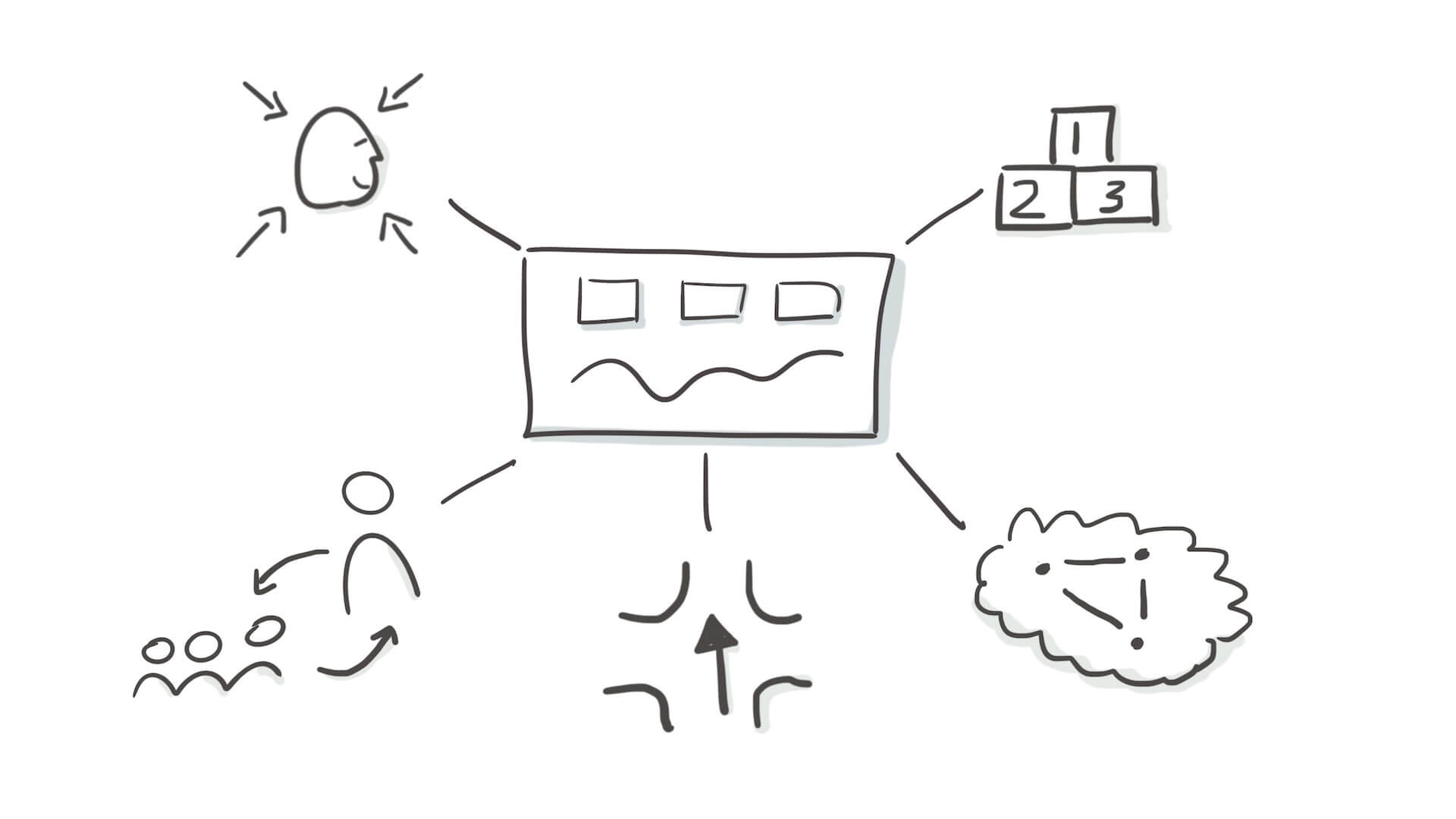
There's a simple explanation for why you see customer journey maps popping up everywhere: the customer experience wave.
Eventually, price and quality reached points where, frankly, not much more could be changed to bring the customer in the door—at that point, when it became clear that you had to compete on something more than the price or quality of your product—we began to study customer retention, look at it as a science, and consider it as a method of competition.
Source: The Customer Journey: A History and a Future
Organizations across the globe have become aware that delivering a good customer (and employee) experience leads to a competitive advantage, lower costs, and more profits.
But “customer experience” is just another hollow and overhyped phrase when you don't act on it. And here's where customer journey maps come in.
Customer journey maps help organizations better understand:
- the needs of their customers,
- where opportunities lie to align their offerings with those needs, and
- what has to be done to deliver those offerings, from an inside-out to outside-in perspective.
Smart organisations have good reasons to invest in customer journey mapping these days. They understand that they need practical tools like customer journey maps, which enable them to work on actually delivering a better customer experience and not just talking about it.
A study by McKinsey showed that organizations who focus on journey optimization perform better in terms of revenue, customer satisfaction, and lower cost to serve than their competitors.
There's a growing stack of evidence that driving customer-centric change through customer journey maps is not just good for customers—it's good for businesses too.
The History of Customer Journey Maps
When starting this guide, I had no clue what the origin of customer journey maps was. Suddenly, they were just there. But I did a little bit of research, and this is what I found:
The exact origin of the term customer journey map is unclear. The basic idea of looking across touchpoints seems to have its roots in Jan Carlzon’s concept of moments of truth.
Source: Mapping Experiences
The historical roots of the customer journey perspective are challenging to trace, as it has appeared in different fields of practice and research more or less in parallel.
Source: Customer journeys: a systematic literature review (PDF)
So, it seems that it's hard to say who came up with customer journey maps and when that happened. Depending on your definition, you could trace it back to as early as 1989 or even 1984.
But it seems that, in the years 2006-2008, multiple trends were converging and strengthening each other. In that period, the term “customer journey mapping” really became popularized for a wider audience.
The year 2011 was also significant with the publication of This is Service Design Thinking, which made the field of service design accessible to nondesigners, thus spreading the importance of customer experience to the boardrooms.
When should I create a customer journey map?
If you've ever created a journey map that didn't give the results you hoped for, it's very likely that you didn't answer this question at the start of the process.
A journey map is always just a means to an end. Don't make the mistake of creating a map just for the sake of creating a map.
In general, there are four common scenarios when you'd consider creating a customer journey map.
1. To Create Shared Understanding
The visual aspect of a journey map makes it a great tool to build shared understanding.
Very often, stakeholders and departments have a different take on reality. They all have an idea about what the customer journey looks like, and these ideas usually don't align.
So, visualizing the journey (based on research), making it explicit in a map, and gathering the different stakeholders around it is a very effective process to find common ground and break down internal silos.
2. To Capture User Research Data in a Meaningful Way
User research is great, but it's also very messy. You end up with a lot of qualitative data that can be hard to structure.
Customer journey maps can be a great tool when you want to organize loose quotes, photos, and videos so you're able to get actionable insights out of this data.
The customer journey provides the common thread through all of the data. It helps you order things in a coherent and meaningful way.
Once you have the journey, all the research data becomes a big puzzle you just need to put together.
3. To Guide User Research
A good customer journey map helps you ask better questions. So, you can use the map when you want to do research in specific areas of the journey.
You could, for instance, create a journey map that has gaps in parts of the journey. Then use this map in a workshop with customers or internal stakeholders to ask questions about those gaps, questions like: We know the customer engages with your department in this stage of the journey, but how does your staff experience this?
Take a look at the most recent journey you've mapped. Which questions can you ask based on this map that you didn't think of before?
A journey map usually leads to more and better questions than answers. This is a feature, not a bug! Embrace it.
4. To Make Smarter Decisions
In the end, if you don't take actions based on the insights you get from the journey map, you've just got an art piece to hang on your wall.
When you need to make decisions about the areas you should prioritize or invest in for your business to become more customer centric, customer journey maps are probably one of the most helpful tools out there.
A map helps you understand how and where the journey of your customer impacts your business and vice versa.
Instead of having to guess which of your 100 ideas you should follow up with to improve the customer experience, a journey map just points them out. You can literally see them in front of you and make a more informed choice.
So, a customer journey map will help you make smarter investments, prioritize the right activities, and make the decision-making process much easier in general.
A journey map is never the final deliverable.
As Marc Stickdorn said during his appearance on the Service Design Show, "A customer journey map is never a final deliverable. It's always a means to an end."
The next time you're thinking about creating a map, ask yourself the question: “What will we do once we have this map?” And reverse engineer from there.
What are the essential elements of a customer journey map?
When you do a Google search for “customer journey map” and look at the images, you'll find a plethora of different journey map templates and formats. Confusing, to say the least.
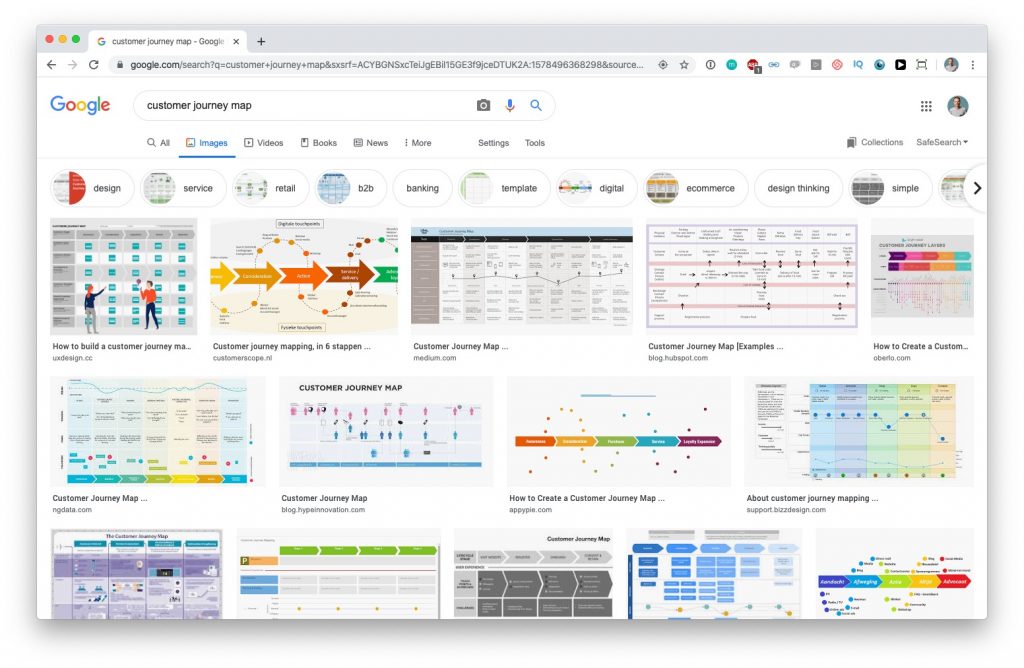
So you might wonder: What are actually the essential elements of a customer journey map?
There's a surprisingly easy way to answer this question, and that is by asking a new question:
How many things can you remove from a map before it stops being a customer journey map?
That's actually quite a lot, as you'll see below.
To call your visualisation a customer journey map, it needs to have at least the following four elements.
1. Customer Lifecycle
This is the most abstract information lane, and it’s at the top of your map. In this lane, you describe the stages or phases of the journey.
You can think of stages as the main chapters in a movie. These stages can be as simple as before, during, and after.
But they can also be more elaborate, for instance, awareness, research, comparison, purchase, use, and retention.
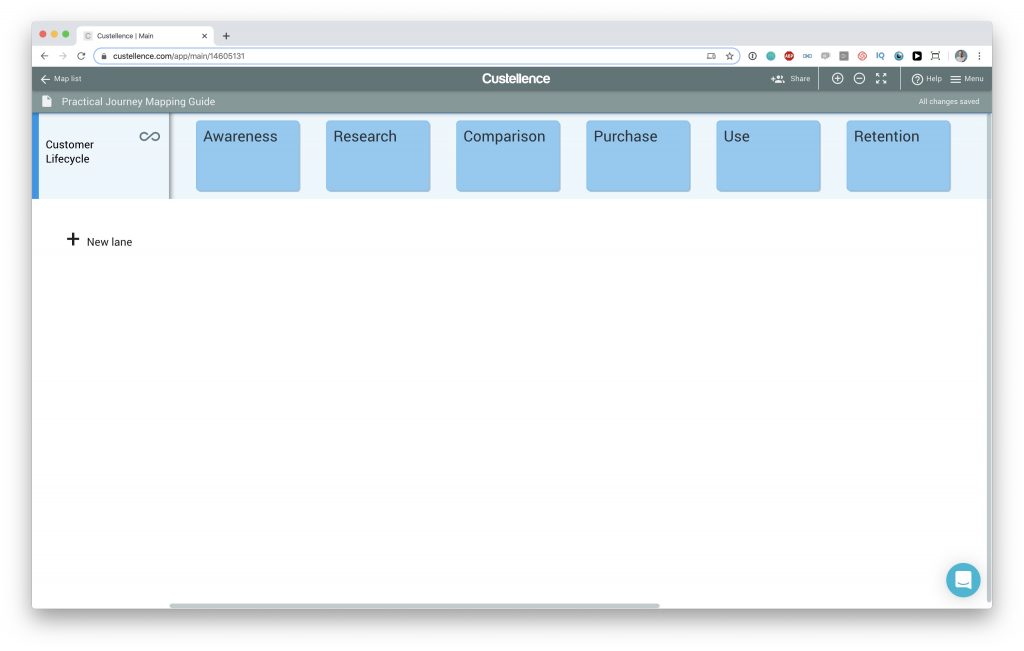
Click to enlarge the image
Think about stages and phases as chapters in the customer lifecycle.
Sometimes, the easiest way is to start with the most basic stages. Once you have your customer activities mapped out, reverse engineer the stages.
2. Customer Activities & Situations
This is the information lane that sits right below the customer lifecycle stages.
If stages as described above are chapters, activities and situations are the individual scenes in the movie.
In the Customer Activities & Situations information lane, you describe which activities and/or situations your customer goes through.
What is an activity? These are the things your customer does that are somehow relevant to your service.
If we're a bank and thinking about our mortgage service, we would map activities like chatting with the neighbors about mortgages, searching for a mortgage advisor, gathering last year’s income statements, etc., etc.
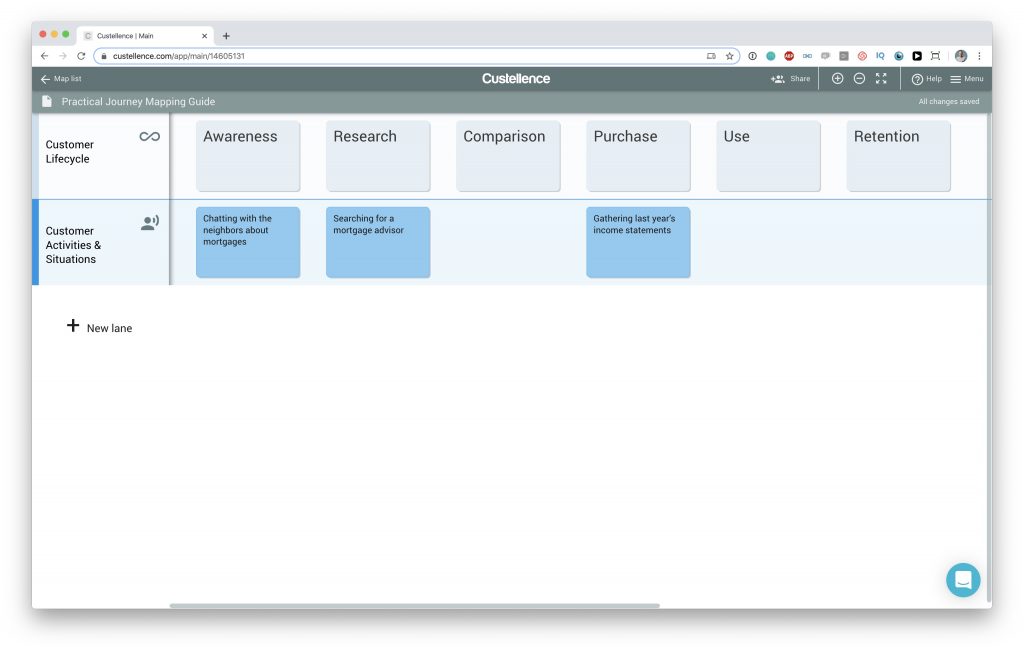
Click to enlarge the image
When done right, activities should go way beyond the actual interaction with your service. They should capture the steps in the journey through the eyes of your customers.
Now, what's a situation? Situations are the moments where a customer isn't actively performing a task but there is a significant influence on their experience.
For instance, waiting in a hospital emergency room is a customer situation, as waiting isn't really an activity but something that happens.
When you can, add photos of these activities and situations. Your goal here is to bring the experience to life. Photos help you immerse yourself in the journey.
Please bear in mind that we're not talking about touchpoints here. Touchpoints only capture the moments where a customer interacts with your company. This is a very narrow perspective on the journey.
Mapping touchpoints rather than activities and situations is a beginner mistake. There's a place to map touchpoints, but it's not here.
3. Customer Needs
Now that we have the chapters and scenes of our movie in place, we need to go one level deeper and make things personal.
The third information lane in your customer journey map is Customer Needs.
In this lane, you describe the needs that your customer has in that specific scene.
The previous two lanes can be seen as pretty objective. They just describe things that happen without judging.
The Customer Needs lane is very subjective and tied to the customer who's going through this specific journey.
Two different customers could go through exactly the same journey but have completely different experiences. In order to make this a valuable lane, you need to have a deep understanding of who your customer is and what they are thinking and feeling.
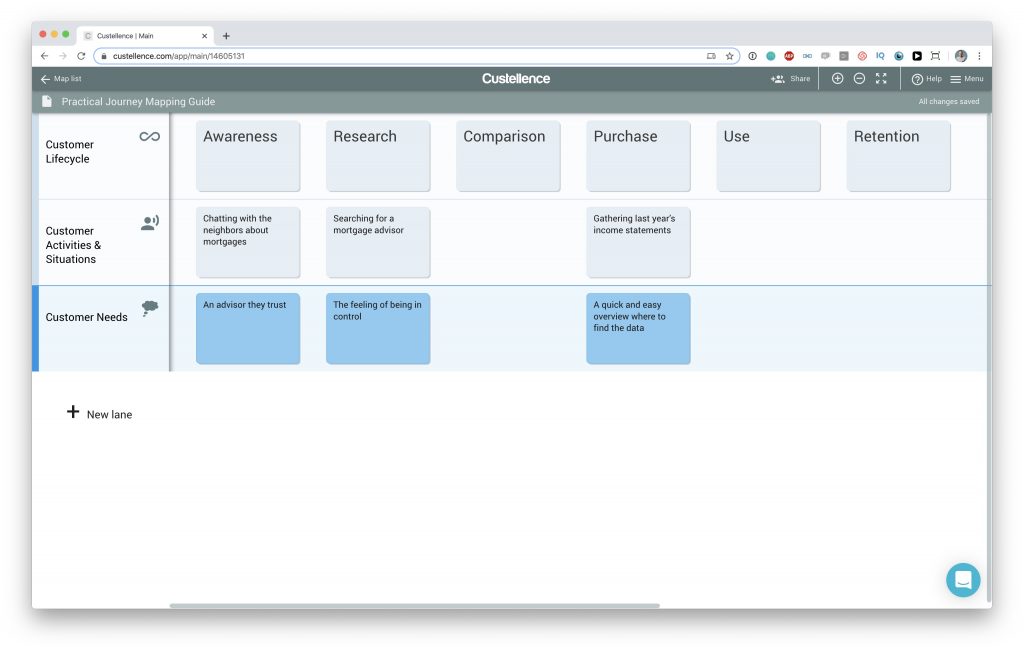
Click to enlarge the image
Are they looking for confidence? Do they feel insecure? Is speed the thing they desire? Or is it about being comfortable?
My advice here: Do research!
Making assumptions and merely thinking you know what your customers need is a guaranteed recipe for disaster in the long term.
4. Customer Experience
The fourth and final information lane is probably the most iconic lane of the customer journey map.
The Customer Experience lane is the curved line that shows how satisfied or dissatisfied your customer is throughout the journey.
When you draw this curved line, make sure you also capture why the customer is satisfied or dissatisfied. Without this, the value of this lane is quite low.
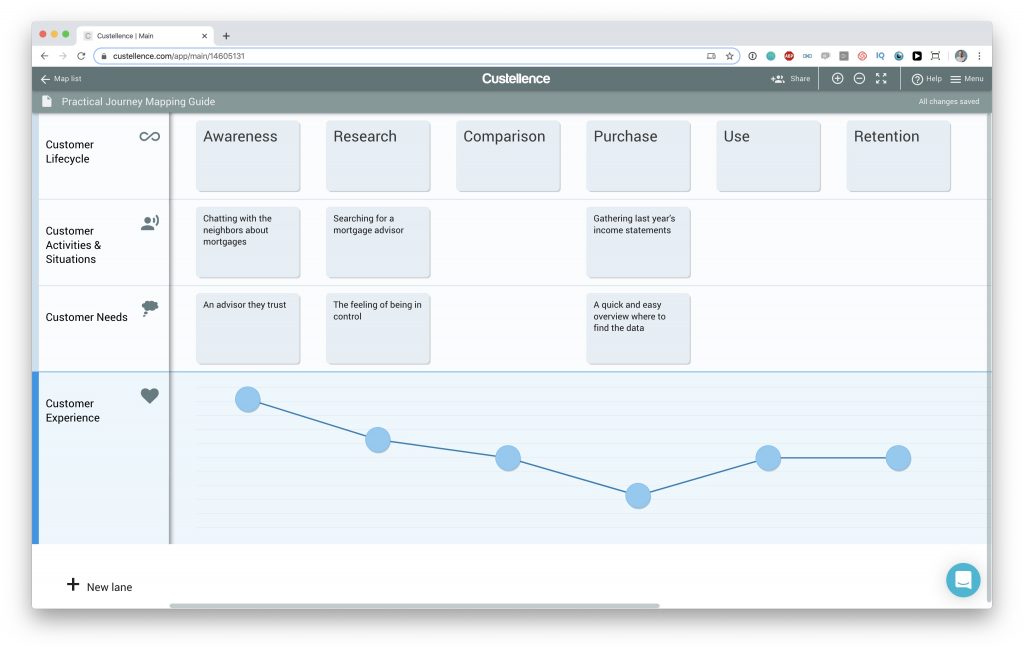
Click to enlarge the image
Just as with the Customer Needs lane, remember that two different types of customers can have a completely different experience of the service.
The Rest
It’s fair to say, if you don't have these four elements in your overview, you don't have a customer journey map but something else.
Now, like I mentioned before, you'll find dozens of different journey mapping templates online that all probably contain more elements than I've discussed here. And that's totally fine.
You'll usually need to add more elements to make the map valuable in your specific situation.
Maybe you need to add Communication channels, Back-end processes or IT Systems. Feel free to do so.
Just make sure you have the four essential elements in place, and build upon those.
When you add a specific set of elements to your map, you might end up with something we call a service blueprint. So, let's talk about that next.
What’s the difference between a service blueprint and a customer journey map?
If you've heard of customer journey maps, you've most likely also heard about service blueprints.
Service blueprinting was developed in the 1980s by Shostack (1982, 1984) and has been further developed and taken up as a method to support service management (Bitner et al., 2008) and service design (Polaine et al., 2013) with the purpose of "illuminating the customer’s role in the service process" (Bitner et al., 2008, p. 71).
Source: Customer journeys: a systematic literature review (PDF)
Sometimes the terms customer journey map and service blueprint are used interchangeably. But is there a meaningful difference between the two? Yes, there definitely is.
The reason a customer journey map is sometimes called a service blueprint is because a service blueprint always contains the four essential elements of a customer journey map. (This is also explained in more detail in the Journey Mapping Essentials masterclass.)
You could say that a service blueprint is an expanded customer journey map. You ask, “Expanded with what?”
Where a customer journey map at its core contains information about the service experience from a customer’s perspective, the service blueprint also unveils how your organization is delivering the service.
A service blueprint is a customer journey map with the added layers of how you deliver a service.
The Onstage/Frontstage
Think about the delivery of a service as a theater for a moment. The service blueprint not only tells you how the audience is experiencing the play but also what happens on the stage and behind the curtains to make this happen.

Photo by Kyle Head on Unsplah
The onstage part of the map shows which "actors" are doing what to deliver the actual service. You need to take a very holistic perspective on actors. Actors can be not only actual employees that your customers interact with but also things like your website.
The onstage is the part where you map touchpoints.
Line of Visibility
When you've mapped the customer experience and the onstage part of your service, you've mapped what we refer to as everything above the line of visibility. And that’s actually quite a helpful way to think about it.
Everything that happens above the line of visibility are things your customer sees or interacts with in relation to your service.
Think of the theater example again. Everything from seeing posters in the city advertising the play, to the website where they make the reservations, to the actual actors onstage performing the play are things happening above the line of visibility.
Of course, to make a service happen, or a play for that matter, a lot of things happen below the line of visibility or literally behind the curtains. This is exactly what you map in the backstage part of your service blueprint.
The Offstage/Backstage
The third layer of your service blueprint is the backstage area. In this area, you map out everything that happens or is needed to actually deliver the service (but customers don't see).
Let's go back to the theater example. In the backstage area of a theater environment, you make out what the light, sound, and set piece people do to allow the actors to perform the play and entertain their audience.

Photo by Marc Schulte on Unsplash
In a business environment, you map things like internal processes, IT systems, and suppliers in the backstage.
Mapping the backstage is one of the most valuable things you can do. Why? Because you make the connection between the customer experience and what happens on the inside of your organization.
Employees who don't interact with customers on a daily basis often don't see or feel the influence they have on the customer experience.
Take legal departments, for instance. The decisions these departments make often have a huge influence on the actual customer experience, even though legal isn't interacting with customers a lot. Unless you’ve got a lawsuit on your hands! 😉
Helping backstage employees understand how they contribute to and influence the customer experience is really powerful.
Just image that the sound guy at our theater isn't aware of the impact he has on how the audience experiences the performance and starts fiddling with the audio during the play. I wouldn't want to be in that theater...
In the same way, the backstage needs to understand that they are the ones the actors onstage rely upon to deliver a great service experience each and every time.
To make a long story short: Yes, there is a difference between a customer journey map and a service blueprint. You can have a customer journey map without having a service blueprint but not the other way around.
The Customer Journey Mapping Essentials masterclass covers the difference between journey maps and service blueprints in even more detail.
Is there a difference with employee journey maps?
You can't deliver a great customer experience unless you have a great employee experience.
And yes, journey maps are also a very useful tool when you want to work on improving your employee experience.
Is an employee journey map just a customer journey map that focuses on the employee instead of the customer? Yes and no.
Scenario A: Your Employee as the Customer
Every organization provides services to its employees. You can even go as far as to say that every employee provides a service to their colleagues.
The first things that might come to mind are classic internal services like HR or finance, but they’re not limited to that. You can also think about the cafeteria and general maintenance as services that keep the organization running and employees happy.
When the focus of your efforts is to (re)design internal services with the needs of your employees in mind, then your employee just becomes a customer in this scenario.
And when your employee is the customer, you can say that you have a "regular" customer journey map but with a very specific customer.
In reality, this type of journey is called the employee journey.
Scenario B: Your Employee as the Actor
In the previous part where we discussed the difference between a service blueprint and a customer journey map, we looked at the onstage and backstage areas of a map.
In a service blueprint, the employee is an actor that is part of the service delivery.
Now, on some occasions, it might be useful to map how an employee experiences certain aspects of the journey next to how the customer experiences it.
Let's say you're mapping the journey of a bus passenger. One of these moments in the journey could be the experience at the moment the passenger walks through the doors.
In the same map, you might also capture how the driver experiences this moment. Is she feeling rushed? Excited to see a new face? Or overwhelmed by the number of people waiting to get in?
In this example, you'd have two curved lines in your map: one for the customer experience and one for the employee experience.
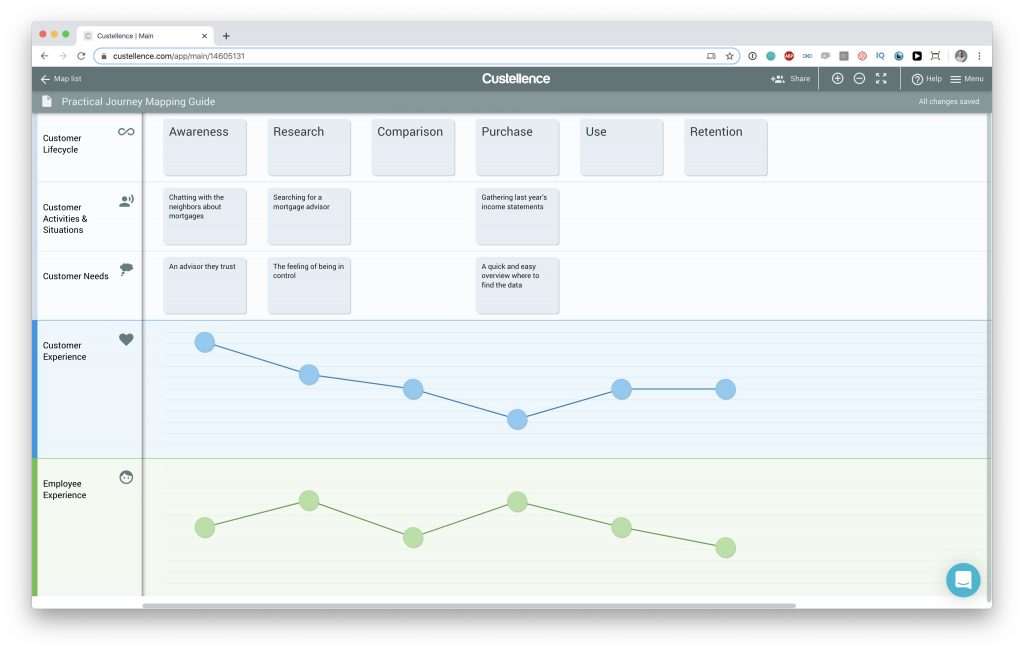
Click to enlarge the image
Mapping the employee experience in your customer journey is often a smart move that doesn't take a lot of additional effort but provides a lot of insights.
So, is there a difference between an employee journey map and a customer journey map? It depends on whether you're working on an employee-facing service or a customer-facing service.
You can learn more about this in our Customer Journey Mapping Essentials masterclass.
How do I create a customer journey map?
The power of a good customer journey map is that it makes complex data accessible and easy to understand for anyone.
But this clarity and simplicity offered by a customer journey map is also one of its weaknesses. What less experienced people don't see is, just because it’s easy to understand, that doesn't mean a map easy to create.
I'd argue that it’s the contrary. It takes a lot of work and deliberation get to this clarity. As with many things, the devil is in the detail.
This doesn't mean you need weeks or months to create a customer journey map. I've seen people create very useful maps in just one day.
What's the secret?
The secret is that you need to follow the right steps.

Photo by NeONBRAND on Unsplash
The process of customer journey mapping is often mistaken for the act of simply sticking Post-it notes on the wall in a sequence. And while that's part of it, it's just a (very) small part.
You'll find the steps below that, when followed in this order, should get you a long way in the direction of a useful customer journey map.
Ready? Here we go!
1. Define your objective.
When your customer journey mapping efforts don't produce the results you hoped for, it's usually because you missed a step in the preparation stage.
Don't make the mistake of rushing a project in order to create a map, thinking that the sooner you start mapping the journey, the sooner you'll see tangible results.
When you don't have a crystal clear image of why you're creating a journey map, you might as well stop now.
As with many things, careful and deliberate preparation sets you up for success.
Here are the three key questions you should always answer before you start mapping:- What is the goal of your map?
- What are the most important KPIs you need to focus on?
- Who needs to be on your team and why?
I know that some of you reading this will think that these are trivial questions that can be answered in a second or two.
There's a mantra that I adhere to in these situations: Go slow to go fast.
2. Map the right journey for the right customer.
Now that you know exactly why you're going to invest your valuable time to create a customer journey map, the first question that will pop up in your mind is most likely, Which journey should I map?
Also, almost every organization provides multiple services. And like I discussed before, every journey contains an endless number of smaller journeys.
How do you decide for which journey you should create a map?
Here's my approach:
- Start by mapping the customer lifecycle in a very holistic way.
- Pick the stage of the lifecycle where you think you'll be able to add the most value (look at the KPIs you defined in the previous step).
The second step especially is easier said than done. You'll need to know a thing or two about the priorities in your organization.
But the good news is that you don't need to map everything. And you also don't need dozens of maps to start with.
In the beginning, just focus on the journeys that are most valuable to you and your customers.
Now, what about mapping for the right customer?
The goal of a customer journey map is to help you make business decisions. But it's hard to make decisions if you're trying to be everything to everyone.
So, the better you're able to identify the customers you want to serve, the easier it is to focus and prioritize your investments.
There are many methods out there to help you segment your customers, including personas, customer avatars, empathy maps, etc. Which method you pick doesn't really matter at this stage. You will have the opportunity later to go back and refine this.
Right now, just be pragmatic and take these two steps:
- Create an overview of all the different customer types that use your service.
- Pick the most valuable customer in your business.
Yes, this is very similar to picking the right journey.
Remember that this is a general rule of thumb. Of course, there are moments where you may want to pick a different type of customer to focus on.
Now that you know which customer you'll focus on and why, you need to define their goals, needs, desires, obstacles, etc.
How to create useful personas, customer avatars, and empathy maps goes beyond the scope of this guide. If you're interested in learning more, check out this video.
Okay, you've managed to stay with me this far. Have you realized that you haven't yet mapped any part of the actual journey? Weird, right? I know!
I can guarantee you that the first few times you take this approach, it will feel uncomfortable. Your hands will be itching to take that stack of sticky notes and start mapping.
But I would argue that when you don't take these steps, you're taking a very big gamble in the hope that you'll end up with a useful customer journey map.
Are you willing to take this risk when you know what you can do to avoid it? I’m guessing not.
So, let's move on to the moment where you can finally start mapping the journey!
3. Map the customer perspective.
Now that you know why you're creating a customer journey map, for who, and which journey, it's time to start mapping.
But wait! I haven't done any user research yet...
That's the right attitude! User research is everything. Being able to ground your journey map in evidence from the field is invaluable.
Can I create a journey map based on my assumptions without doing any research!? Yes, but proceed with caution.
The first thing you're going to map is the customer perspective. To get started, just create the structure of the Mother of All Maps described before.
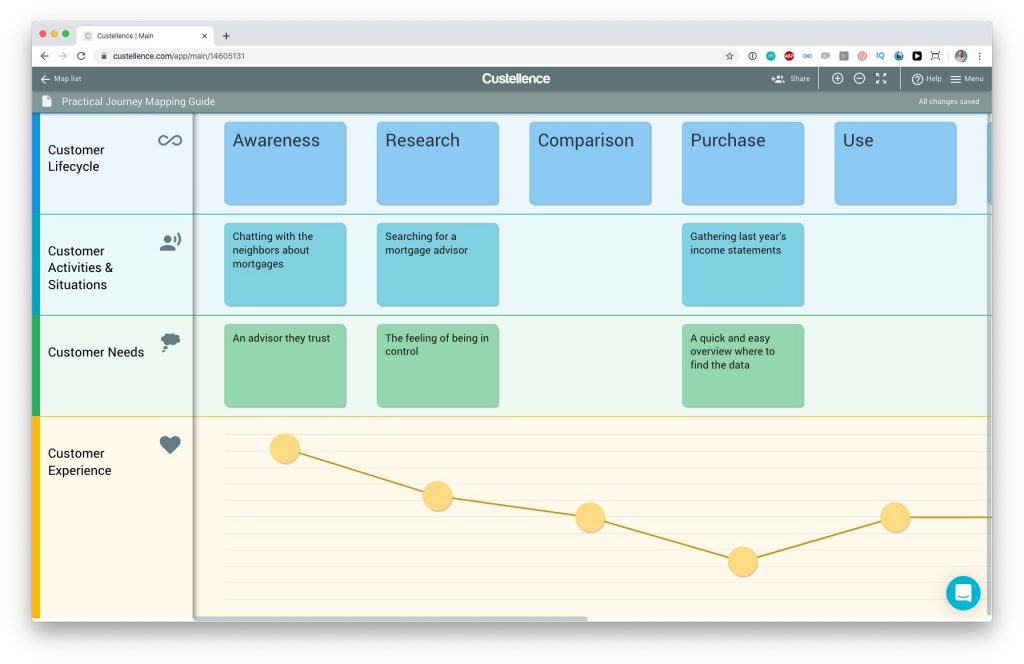
Click to enlarge the image
If done right, your map should contain these four lanes:
- Customer Lifecycle
- Customer Activities & Situations
- Customer Needs
- Customer Experience
That's fine to start. You can always expand and add more lanes later.
But a customer journey map with empty lanes is quite scary. Where do you draw the first line?
Make the first entry on your empty journey map the customer activity where your customer interacts with your service for the first time.
Once you have that point set on your map (usually somewhere in the middle), you can work your way out to the sides.
There are different strategies to define where your journey starts and ends. For now, let's say that when you have around 20-25 moments in your Customer Activities & Situations lane, you're off to a pretty good start.
Finding the right detail level in your map can be challenging. Don't waste a lot of time overthinking it in the beginning. Just start mapping and iterate over time. It's easier to align the detail level once there's actually something in your map.
Okay, you've got the customer journey mapped out. Are we done? Could be. It all depends on why you were making the map in the first place.
In practice, I've found that a customer journey map that just contains the customer perspective is rarely enough. You'll usually want to add (at least) one more area to your map. And that's what we're going to talk about next.
4. Map the business perspective.
In this step of the mapping process, you're going to look at the customer journey from a business perspective.
“Wait, what? You just told me that a customer journey map just has four key elements, and I've mapped those in the previous step!”
Yes, that's true, and it's fair to say that by also mapping the business perspective, we're slowly moving toward a service blueprint. Yet, I'm still going to advise you to do that.
Why? Very simple. Not everything is important in the customer journey.
By connecting the business perspective to the customer perspective, you'll be able to make smarter decisions about where to focus your energy.
I'm sure you still remember that you had to define your most important KPIs in Step 1. Here's where those KPIs come in handy.
So, what should you add to your map from a business perspective?
The truth is, in contrast to the customer perspective, there is no real consensus about this "bottom part" of a customer journey map / service blueprint.
Every organization has a different structure, and every project has different requirements. You have to figure out what you need to add from a business perspective to get value out of the map.
As you learn about what's important for the business, this bottom part of the map can eventually become much bigger and more elaborate than the top part of the map.
But I get it, you need a starting point. So here's my advice:
Create a lane where you map the (potential) impact on the KPIs you've set previously.
In this lane, you're going to indicate, for instance, how a negative experience (pain point) in one of the customer activities is impacting the KPIs.
Let's go back to the theater example we used before. From the business perspective, you'd like to know how long lines impact bar sales before the show starts, or how they impact the rating of the show and return visits.
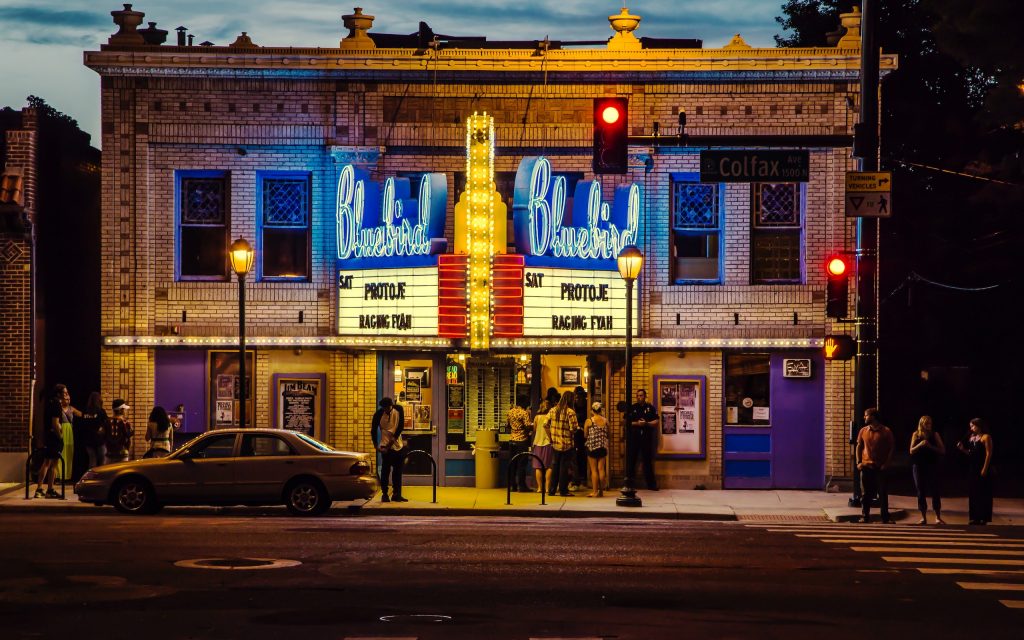
Photo by Mark Hessling on Unsplash
You'll find that you're going to have to make assumptions in the beginning, as most organizations don't collect reliable metrics on the impact of customer experience on business KPIs.
That's okay since, in the next step of the journey mapping process, you're going to create hypotheses and generate ideas on how to test them.
5. Identify insights and opportunities.
When you don't do anything with the journey map you've created so far, you've just created an image of which the value can only be judged by its artistic qualities. Unless you're shooting for a career as an artist
What you want to do is find insights and opportunities that you can act on, and not just any insights and opportunities. These should be insights and opportunities that generate the most value for you and your customers.
Where do you find these insights and opportunities? You can start looking for them by asking one of two questions:
What are the lowest points in the customer experience?
Is there a pattern across the different pain points in the customer experience?
The lowest points are easy to spot in the journey map by looking at the emotion curve in customer experience lane. A pattern could be something like a lack of clear communication that causes frustration.
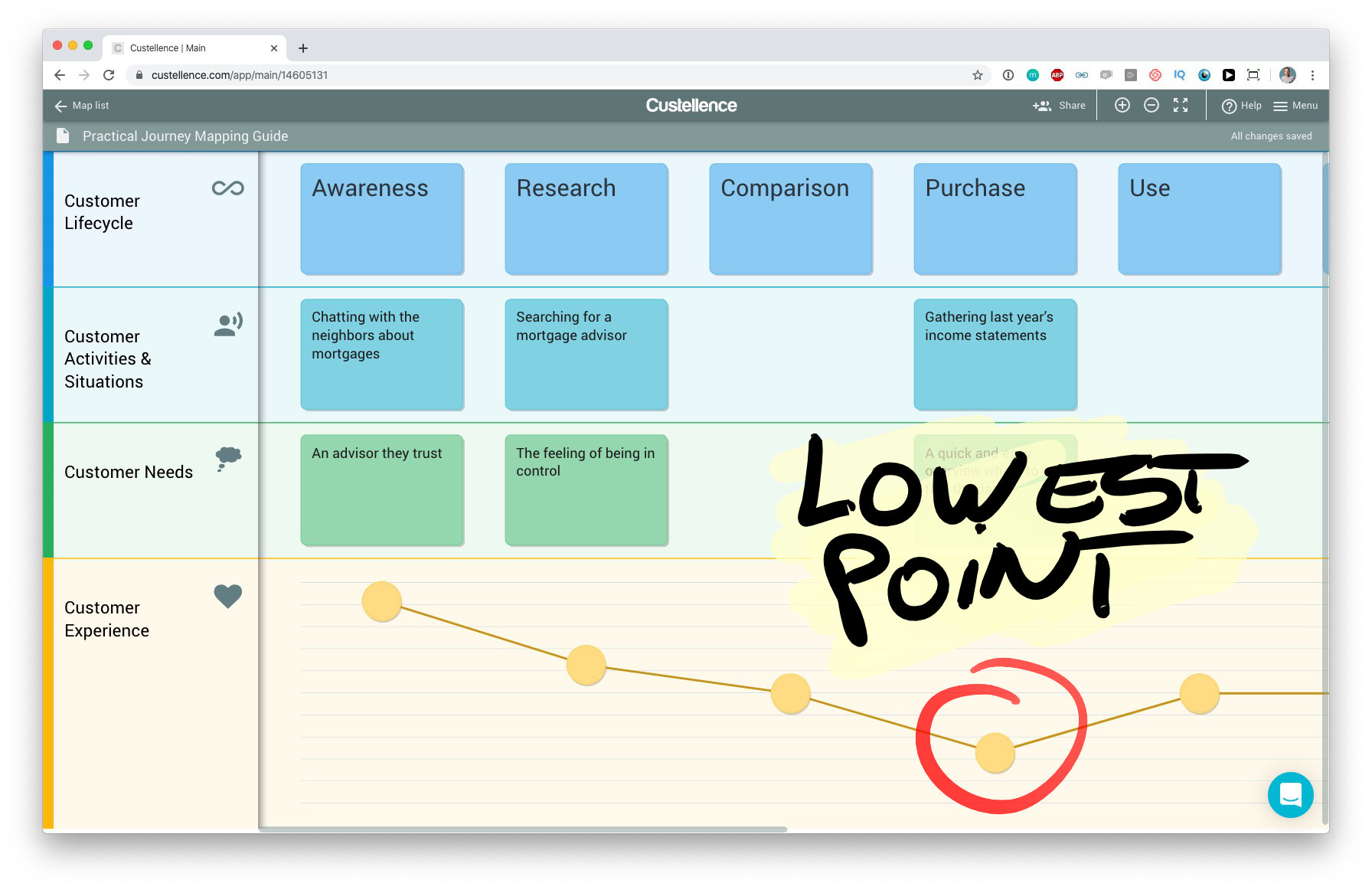
Based on the answers to these two questions, you can start to formulate hypotheses, or design challenges, as I like to call them. An easy way to do that is to formulate a sentence that starts with "How can we..." or "What if...".
In the final step, you simply prioritize which hypotheses you're going to act on.
For this, you'll have to look at what matters most to your customers. Luckily, you of course created a good customer avatar in Step 2, which quickly gives you the answer.
Now just cross reference this with the business KPIs you defined in Step 1, and voila! Left are your top three ideas to pursue in the coming weeks and months.
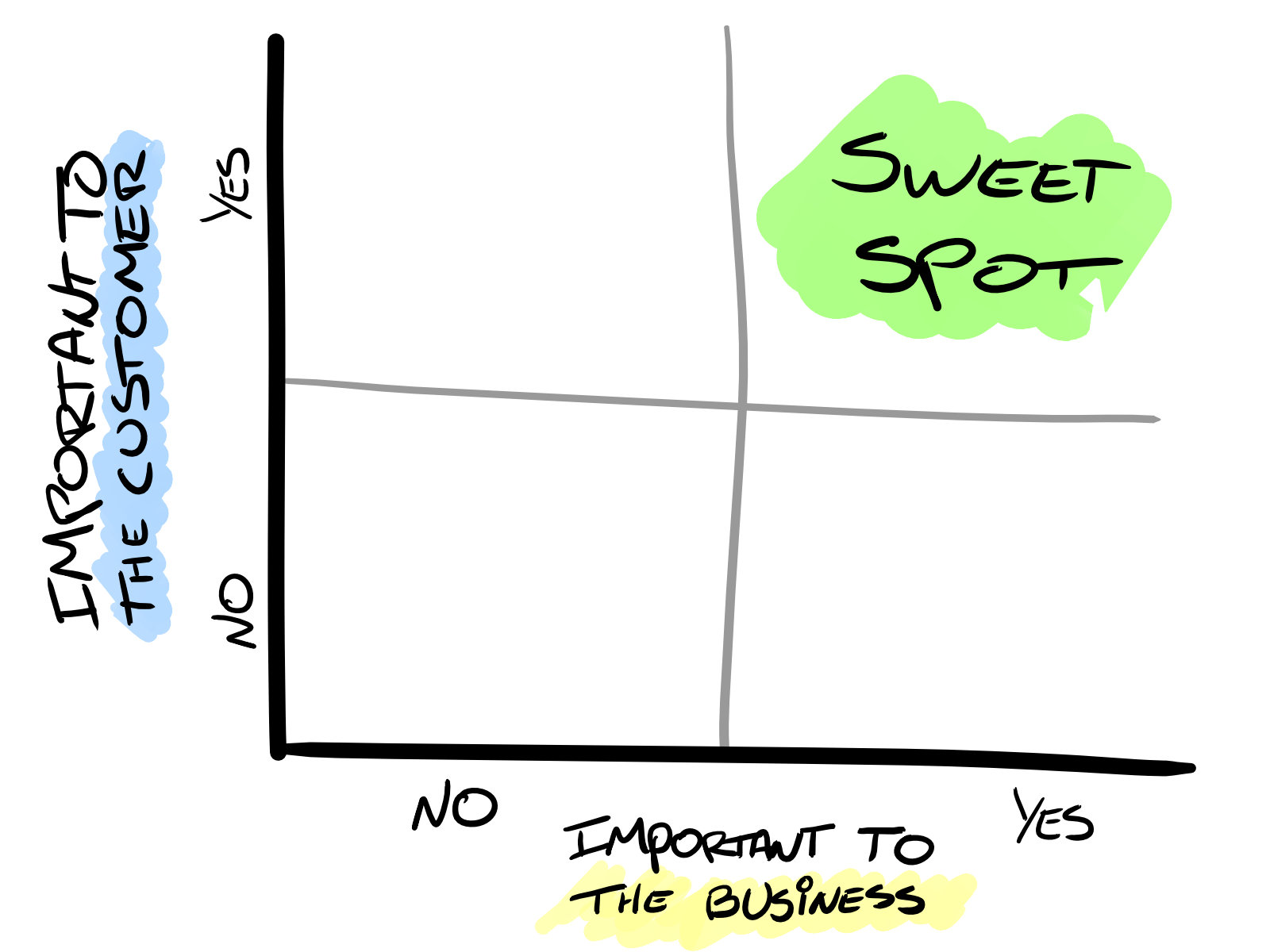
That wasn't so hard, was it? 🙂
The amateur stops here. The professional just begins.
Whether you're done right now or not depends on the objective you've set for yourself.
The truth is that most people (and guides on customer journey mapping) do stop here.
When your goal is to drive sustainable customer-centric change, the journey map can never be your final deliverable.
If you treat your map as simply a visual overview, you only get a one-time return on your investment. Inevitably, your journey map will quickly lose its value and end up in the trash once the Post-its start to fall off.
What you need to do instead is use your customer journey map as a customer experience dashboard and work with it on a day-to-day basis.
This is what separates true customer experience professionals from the amateurs.
I have to be honest, this isn't easy. But when you succeed, the reward is huge.
This is what you must strive for when you don't want to go over the customer journey mapping process every few months and feel like you’re running in circles without making much progress.
In order to get to this next level, you'll need to embed the customer journey map in the "operating system" of your organization.
How you do that demands a full guide on its own. In fact, it's such a vital part of the journey mapping process that the whole final module of The Perfect Map course is dedicated just to this.
But to get you started, here are a few topics you can already think about:
- Are there regular meetings where you can make the customer journey a key part?
- Can you set up a CX board to coordinate cross-department initiatives?
- Can you find or create KPIs that focus on CX and span multiple departments?
Okay, this has been quite a long answer to the question: How to create a customer journey map? I'm glad you made it all the way here!
If you follow these steps, you should be off to a good start and have a pretty solid foundation.
The generic customer journey mapping process really isn't that hard to grasp. That's probably also why so many people are creating maps these days (although they usually miss Step 1).
Once you start mapping, you’ll discover that the devil is in the detail. There are a lot of small nuances that can make or break your journey map.
If you don't have the time or energy to figure out all those small details by yourself through trial and error, I strongly advise you to take a look at The Perfect Map course and see if it's something for you.
In The Perfect Map, you're guided through the journey mapping process in even more detail and with more real-life examples.
We could talk all day about journey mapping, but you'll only get results once you start doing it. So, roll up your sleeves, don't overthink it, and just start mapping.
Your customers will thank you. 🙂
Where should my customer journey start and end?
Because you don't have the resources to map the entire customer journey in detail and almost never do, you might wonder, Where should my customer journey start and end?
We already talked about this in Step 3 when we touched on mapping the customer perspective. Now it's time to dig a bit deeper into this.
The theory of a customer journey map is simple. But when it's you standing in front of a blank journey map and you have to make a decision about what to add, reality slaps you in the face.
This can be paralyzing because you want to do it right, right?
What tends to happen is that you either:- continue having self doubt and over-analyse it until you are 100% sure you know what to do or,
- enter into pointless debates with your colleagues about what the right way forward is.
Both situations are far from ideal and will cost you a lot of time and energy. So let's get this over with!
Two Practical Strategies
Here are two strategies you can use to determine where your customer journey should start and end.
1. Start in the middle. This is probably the easiest approach. Pick the first moment of interaction your customer has with your service and work your way out to the sides. Keep adding customer activities and situations until you reach about 20-25 items. If you feel that, after doing this, you're still missing important steps in the journey, replace some of the ones you have with more of those that you feel are important. Remember that the goal here is not the map but the entire journey.
2. Work your way in. In this approach, you start by picking a random start and end point of the journey. Once you have those two points, add three important customer activities in between. Then continue breaking the journey down by adding three new customer activities between two points. You're done once you have 20-25 customer activities in your map.
These two strategies have worked for me in 90% of my journey mapping projects, but you should consider them a rule of thumb rather than a fixed set of rules. Be critical and do what your situation requires.
I can't stress this enough, customer journey mapping is an iterative process.
You do something, reflect on it, and update where needed.
If you have this iterative mindset, you really don't have to worry where your customer journey starts and ends. Just start mapping, and you'll learn where the sweet spot is as you go along.
Don't make these mistakes!
The first giant mistake you can make is this: When picking the start and end points of your customer journey, you spend too much time thinking about what those should be without actually mapping anything. But I think we've covered that enough above.
The second giant mistake you really don't want to make is to take the moments where a customer starts and stops engaging with your service as the start and end points of your customer journey.
So, coming back to the theater example we used before, what you wouldn't want to do is start your journey map the moment the customer walks through the door and end it the moment they leave the building.
What you're doing here is taking a process-oriented mindset to a customer journey. This is really a no-no.
The experience from a customer’s perspective never starts at the moment they have the first interaction with your organization.
It starts when they book the tickets online or look at the theater schedule for the upcoming month. Or, it could start as early as them thinking about date night.
Why should you bother looking beyond the interactions with your services?
Well, those before and after moments usually hold a lot of clues about how the actual service might be improved. It's a shame if you overlook them.
There's definitley more to say about where and when the customer journey starts but just make sure you stay clear of the mistake mentioned above.
How detailed should my customer journey map be?
I've seen (and made) very large journey maps that printed out as posters span several meters, and I've seen maps that are drawn on the back of a napkin.
Finding the right detail level in your map is probably one of the things that requires the most practice.
It's definitely not the case that more detailed journey maps are necessarily more useful.
When your goal is to build shared understanding, a high level map will probably serve you better. A lot of details will only be distracting for the conversations you need to have.
Journey maps with a lot of details are useful when you're moving into the planning and execution stage of a project.
In most customer journey maps, you can identify four detail levels—from a high level Customer Lifecycle to a detailed process flow.
This article explains how these four detail levels work and when you should pick which one.
How do I run a customer journey mapping workshop?
In most organizations, it's impossible to improve the customer experience all by yourself. You'll need to work together with other people within the organization in order to get anything done.
That's why customer journey mapping is or should always be a collaborative activity. And this type of collaboration often happens in workshops.
Done right, you can achieve a lot when you manage to get people in a room to work together on the same goal.
But before we continue, we need to answer the question: What is a customer journey mapping workshop, anyway!?
It's a very broad term used for any kind of interactive session where the customer journey map is the thing that, in the end, ties all the different conversations together.
So, what does a successful customer journey mapping workshop look like?
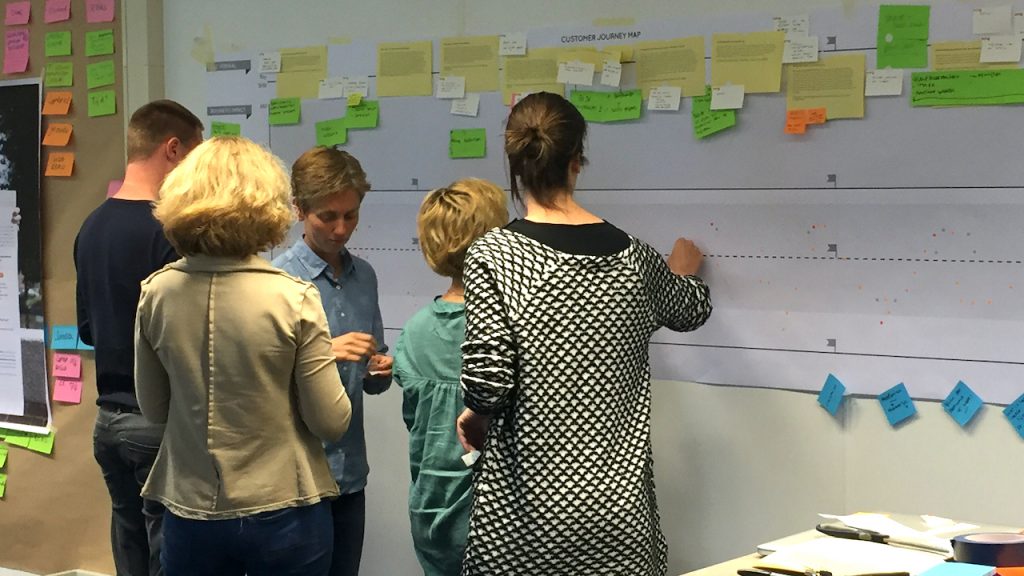
The bad news is, there's no single right answer to this question. The structure of your workshop will depend a lot on why you're working with a customer journey map in the first place.
The good news is that when you already know how to run a productive and engaging workshop, you're halfway there. It goes beyond the scope of this guide to explain the ins and outs of how to do this. But there are many good resources you can tap into.
As with any workshop, you should have clear answers to important questions like:
- What do you want to see as an outcome?
- When will you consider it to be a success?
- What do you see as the next step?
- Who should be in the room and why?
- How much time do you have?
If you go into journey mapping mode before having answered these questions, your chance of actually getting a valuable outcome from the workshop are pretty slim from my experience.
Okay, let's assume you've answered the questions above.
The structure of your workshop will vary a lot based on the stage of the journey mapping process you're in:
- Are you going to analyze research data and look for insights?
- Do you need to build a shared understanding of how different stakeholders perceive the current customer journey?
- Is your goal to identify opportunities and generate ideas?
- Or, is the sole purpose of your workshop to align internal stakeholders?
All of the options above are valid reasons to host a workshop in which the customer journey map plays a role. But as you can imagine, in each situation, the role of the journey map is different.
By now, I hope you've seen that there is no blueprint for running a customer journey mapping workshop. You'll always want to adapt the workshop to your specific context and situation.
Having said that, I understand that it helps to have some inspiration when you're creating the agenda for your next workshop.
So, you'll find a brief agenda below for a three-day customer journey mapping sprint.
Agenda for a Three-Day Customer Journey Mapping Sprint
Before describing the agenda, I'm going to start with a word of warning about sprints. In general, sprints are rarely a useful format to embed customer journey maps in your organization.
If you want to get the most out of your sprint, make sure it's part of a bigger plan. You have to be able to show how the sprint fits in your roadmap.
Otherwise, you run the risk that people will perceive customer journey mapping as a transactional task that can be checked off in three days, which is a twisted view of reality, of course.
Unless you want the value of your efforts to vanish in a matter of weeks or even days, you need to make sure that the results of your sprint have fertile ground to land in.
Now, assuming that you've prepared your workshop properly as described above, let's look at what the goal would be on each day of the sprint.
Day 1: Understand the current situation.
Everyone in the room will have some assumptions about what the current customer journey looks like. People want to hear and be heard, so I found that it really helps to get that on paper first.
The easiest way to do this is by mapping the "as-is" customer journey.
Once you've done this, expand the journey with existing bits of qualitative and quantitative research data. Prior to the sprint, ask around the organization about what kind of data others could contribute.
Next to mapping the existing customer journey, you should also answer these questions on the first day:
Why are we focusing on this specific journey?
What are the important KPIs in this journey?
Which customers are we focussing on, and what do (and don't) we know about them?
The goal of this first day is to have a clear and shared understanding about what the focus is of this sprint, what you already know about the customer journey, and why you still need to do research.
Day 2: Take the outside-in perspective.
The second day is the most challenging. On this day, you'll want to step away from the current customer journey and let go of the specific topic you’re working on—especially when you're working with experts who have been in the organization for a long time.
On Day 1, some of the sprint participants will still be under the impression that they already know everything they need to know about the customer and the journey, so why spend our time doing research, right?
At the end of Day 1, it should become clear that there are always knowledge gaps or assumptions that need to be tested. That's the reason why it usually works better to take the outside-in perspective on Day 2 rather than Day 1.
So, if you're mapping the journey of someone going to the theater today, you'll want to let go of that theater.
The goal of this second day is to step into your customer’s shoes and understand the experience from their perspective.
If going to the theater is a way to spend quality time with your spouse, for example, then quality time is the topic that you want to get a deeper understanding of.

Photo by Tim Foster on Unsplash
You would do this by researching questions like:
- What does quality time mean for my customer?
- When do they feel it's quality time that’s actually well spent?
- What are other quality time activities they engage in?
My preferred way to research these questions is through direct interaction with (potential) customers. The simplest form is to go out on the street and talk to people. You'll be surprised at how much you'll learn!
If you can, it's smart to do some of this field research beforehand as homework. This will not only get you valuable data but also get the sprint participants in the right mindset.
At the end of Day 2, you should have a much deeper understanding of how your customer experiences your service and what they value in that experience.
Day 3: Find the most valuable opportunities.
On the third day of your sprint, you're going to look for the most valuable opportunities that will enable you to improve the customer experience.
You're going to do that by mapping the “to-be” customer journey.
The to-be journey is an improved journey that you (or rather your customer) would want to go through.
And there's always a gap between the as-is journey that you've mapped on the first day and the to-be journey you're going to map now. (If there wasn't a gap, you'd be offering the perfect customer experience already, and there isn't a need for you to go through this process.)
So, based on what you've learned yesterday about the needs and desires of your target customer, you're now going to look at the as-is journey and define where the biggest pain points are. Where is there a big gap between what your customer expects or wants to experience compared to current reality?
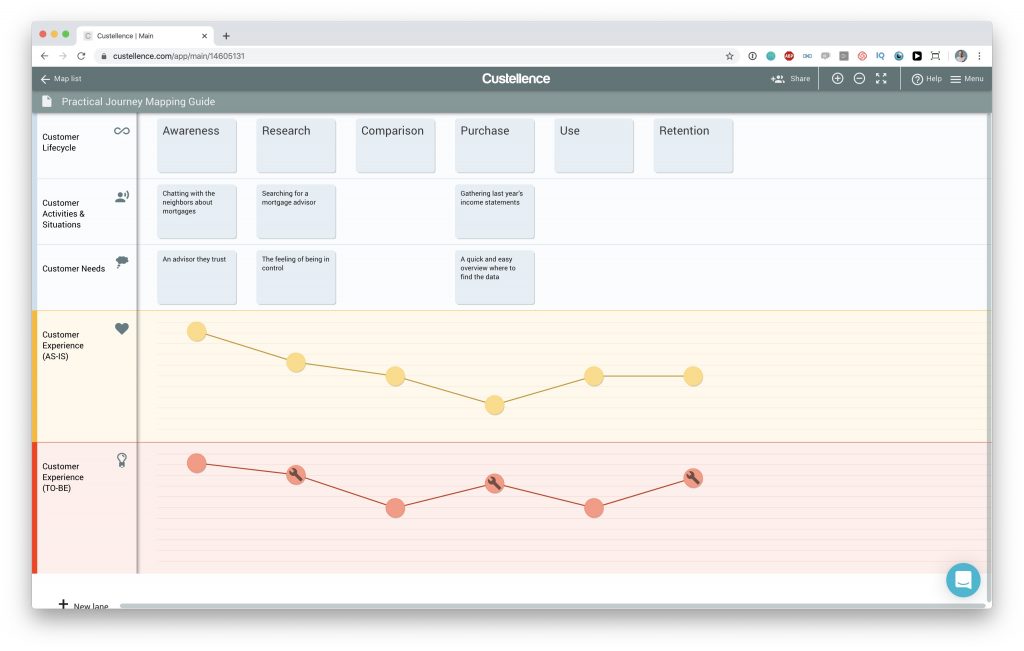
Click to enlarge the image
Your to-be journey could be a second, separate map, or you can mark some of the opportunities in your existing as-is journey map. This depends on how many things you're going to change in the as-is journey.
If there are a lot, your as-is journey map will get cluttered, and you'll lose the overview. It's better to create a separate map in that case. A separate map also makes it easier to compare the current journey with the desired journey.
You should end this third day of your sprint with your top three feasible ideas on how you're going to improve the customer journey.
The ideas should be ranked by how important they are to your customer and to the business.
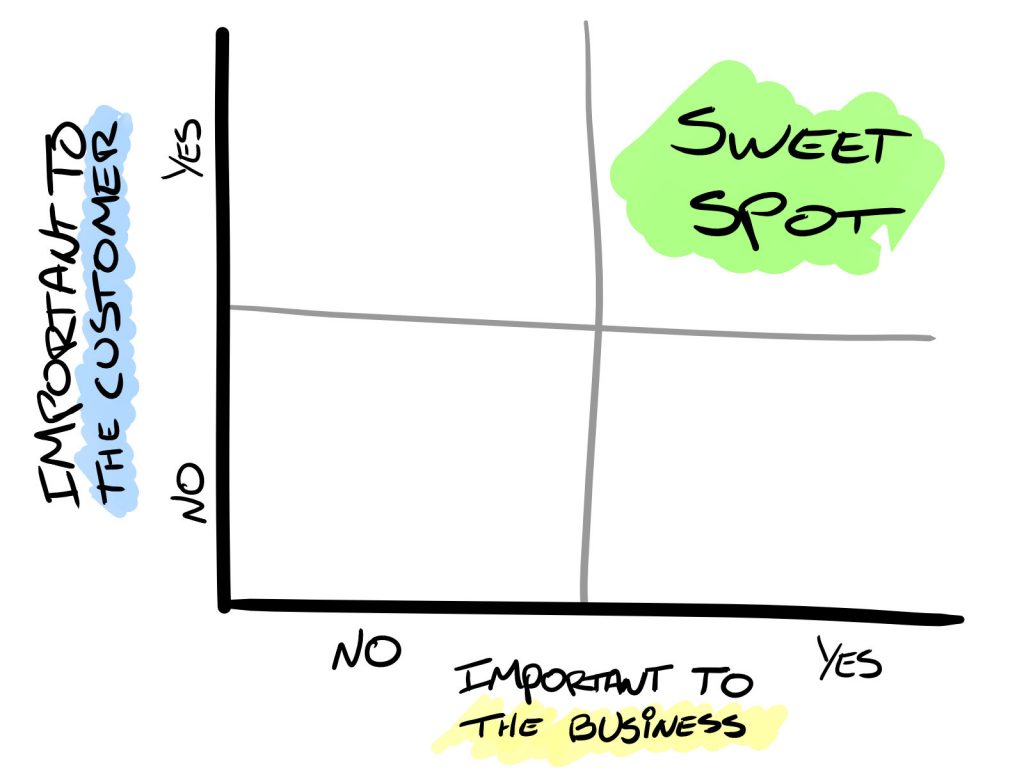
Like I mentioned earlier, it's crucial that you know at the start of your sprint how you're going to continue with the results.
It's great to have a top three. But when there's no capacity within the organization to actually do something with these ideas, you’re going to have to find that now. That usually takes away all of the momentum.
In short, to get the most out of your efforts, always make sure your sprint is part of a bigger roadmap.
Creating Your Own Workshop Agenda
I've ran dozens of customer journey mapping workshops, and every session was different. But don't let the fact that there's no fixed blueprint scare you. Running a successful workshop takes patience and deliberate practice.
If I could give you one tip, it would be to invest enough time and attention in answering the preparation questions. Do this right, and you'll see that everything becomes much easier.
You'll also want to learn about good workshop facilitation techniques (or hire an experienced facilitator). This is a fundamental skill that will benefit you in many other areas as well.
I almost forgot to mention this in all I’ve said before, but next to being useful, customer journey mapping workshops are also a lot of fun. 🙂
I’ve created a customer journey map. Now what!?
First of all, congratulations!
There's a radical difference between consuming a customer journey map and actually creating one yourself. Your appreciation for what it takes to deliver a great customer experience changes forever.
Now, I hate to break it to you but...
Mapping the customer journey is the easy part.
A customer journey map is always a means to an end. A true CX professional never creates a customer journey map as a final deliverable.
So, the real fun (and challenge) starts once you have the map and can finally start working with it.
This topic deserves a separate guide, but until then, following are four things you should do with your journey map.
1. Keep updating the map.
Most customer journey maps are the result of a project. The challenge with projects is that they tend to focus on achieving a fixed result. Once that result has been achieved, people move on to the next project.
When you've created a customer journey map in your project to help you achieve that result (because a journey map is always a means to an end), there's often no incentive to continue using the map.
You've got the insights you needed. You're done. Right? Unfortunately, this is usually the mindset.
What happens six months down the line, when you or your colleague needs to work on a similar part of the customer journey? You usually have to start journey mapping all over again.
Even when you don't want this to happen, it happens naturally when no action is taken. I'm sure you've seen the journey maps on the wall from which the sticky notes have started to tumble to the floor after a few weeks.
Fortunately, there's a way to prevent this from happening.
Treat the journey map as a garden that keeps producing a lot of value when you do a little bit of maintenance once it's in place.
Sounds great! But how do I actually do that?
Part of your project should be to set up a structure, if it's not in place already, where someone takes ownership of the journey once the project has ended.
You can, for instance, decide to keep the project team going after the project. The role of this team could be to meet up on a weekly basis to update the journey.
Then, the next time someone in the organization wants to understand the customer journey, they don't have to start from scratch. Imagine how much time and money that will save.
The way to keep a customer journey up to date is by making sure that someone has the responsibility and ownership to do so, but that's not enough.
You also need to use professional journey mapping tools that make this easy. Otherwise, it won't happen.
When the process of updating your map is cumbersome and you have to spend most of your time moving (virtual) sticky notes around, the chances of keeping this up over a long period are pretty slim at best.
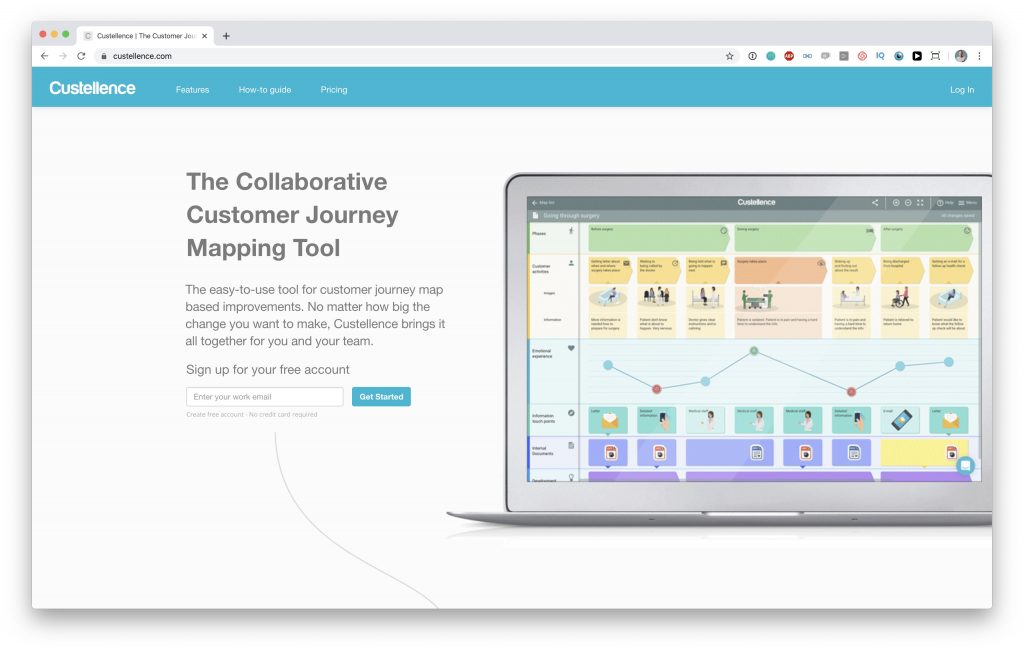
In order to keep your journey map up to date, use a professional tool that makes this task easy and allows you to focus on what's really important. I've reviewed tools like Custellence and found that it’s one of the best available these days.
So, how will you turn your customer journey map into a garden?
2. Embed the map in your daily practice.
This recommendation strongly relates to the previous one.
Organizations that get the most value out of their customer journey maps have successfully managed to embed them in their daily practice. This means that customer journey maps are part of existing processes and systems.
The reason these organizations get the most value is because people, projects, and investments are much more aligned. Everyone is contributing to the same shared goal.
The customer journey map is essentially your primary management dashboard for all developments related to customer experience.
They way you achieve this greatly depends on the operating system of your organization.
Do you have a weekly stand-up of which the customer journey map could be a recurring part?
Do your business plans contain a component where they describe the relationship to the customer journey?
Has HR formalized the focus on customer experience in roles throughout every department?
This topic has the tendency to become quite big (really!), and before you know it, you're reorganizing the whole company structure. Of course, it helps to see the bigger picture, but it's important not to get paralyzed by it.
That's why you should start by asking yourself: “How could the customer journey help me on a daily basis? And what can I do to make that happen within my mandate?”
3. Share the map.
As mentioned before, customer journey mapping should always be a collaborative effort.
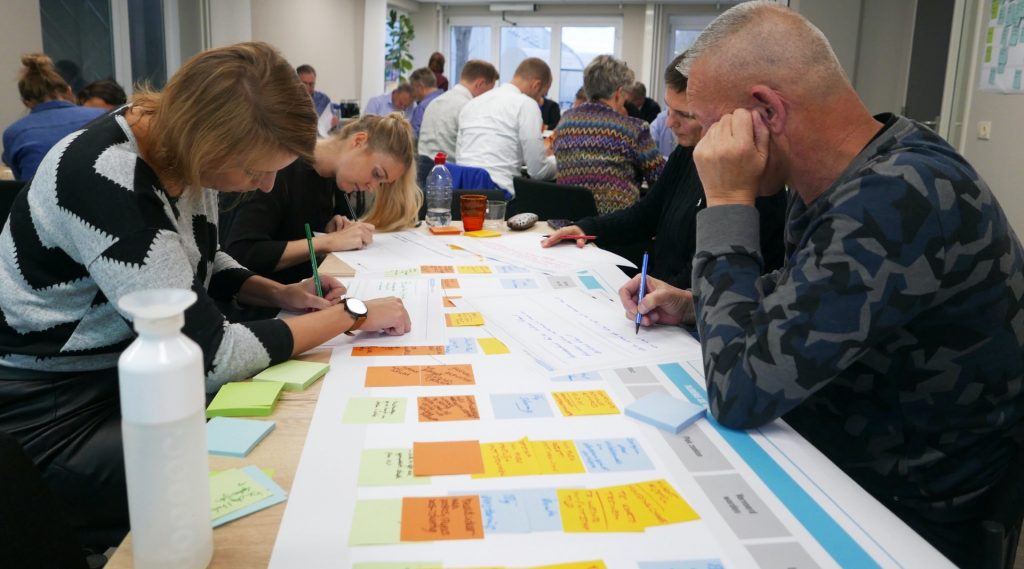
And you should start sharing the journey map as soon as possible with people within the organization. Don't wait until your journey map is ready. If you haven't done so, now is a good time as any to do it.
What you want to do is go to other departments, show them the journey map, and ask how they see their role.
Pro tip: Create an empty lane in the map for that specific department. It will be even more inviting to add some cards there.
For this kind of interaction, I always prefer face-to-face meetings. Why not turn this into a full-fledged internal roadshow?
On the occasion where physical meetups are hard to organize, you can always fall back on sharing the map using online journey mapping tools.
For instance, a tool like Custellence makes this really easy, as it allows you to share the map in a Google Docs kind of way through a simple link that anyone with a web browser can access.
If you're working in an airline on improving the experience of the cabin crew, for example, it might be challenging to get them in a room for a customer journey mapping sprint, as they are traveling all the time.
But with online tools, you can enable the team to collaborate on the journey map regardless of where they are or when they have the time.
With professional journey mapping tools like Custellence at your disposal, you've got no more excuses to not involve people within the organization, even when they aren't nearby.
Remember that evangelizing is (still) an important part of your job as a CX professional. Getting the word out about the journey map you've created will help you do that.
4. Continue doing research.
If you've done your work right, you should have found some interesting opportunities to make a positive impact on the customer experience and on your business.
But a byproduct of mapping any customer journey is that you'll always find new areas that you don't fully understand. The more you understand, the more questions you have.
You may want to understand a particular experience on a deeper level in a more specific part of the journey. Or, maybe you're curious about how a completely different customer segment experiences the same journey.
So, I always recommend making user research an ongoing activity.
When there's no new research data flowing into your journey map, it will die quite quickly.
The way to organize this is not to wait until you've figured out what you want to research specifically.
This doesn't work, because once you know what you want to dig into, you'll have to go through another round of internal improvements, and the momentum will be gone and so will your team.
What you should do instead is allocate internal capacity upfront to do year-round user research. This is easier said than done, I understand. But allocating resources upfront without knowing exactly how they will be invested is quite common.
Just think about marketing departments that usually get a yearly budget to achieve certain goals based on very rough plans for the upcoming year.
Your customer journey map will die when you don't feed it with new data, so make it a priority to collect that data all year round.
Conclusion
One of the key factors separating a CX professional from an amateur is that the professional doesn't focus on the journey map but what they want to do with it and where it should take them.
So, make sure you have a bigger plan and know where you're heading.
Customer journey maps can be very useful but only when they help you achieve your goals.
What are common mistakes I should avoid?
No matter how much you read about customer journey maps, the only way you'll get better is by getting your hands dirty. I hope this guide gives you the necessary direction and courage to start.
I believe that there's a lot of value in making mistakes and learning from your failures.
But sometimes, it helps to avoid beginner mistakes and focus on making the more advanced ones!
So, here are five common customer journey mapping mistakes that you might want to avoid:
Creating anonymous maps. When you don't (clearly) define who the customer going through the journey is, you end up with a map that gives you no direction at all on where the experience can be improved. Remember that there is always a real human going through this journey.
Mapping the journey from a process perspective. This is a nasty one, but fortunately really easy to spot. These are journey maps where the process of the organization is leading your efforts rather than what your customer experiences. In a map, this manifests as a journey that goes from one touchpoint to another. If you're mapping the experience in a hospital emergency room and "waiting" isn't one of the customer situations in your map, then it's very likely you're not mapping from the customer’s perspective.
Starting the journey the moment your in-house process starts. Let's use our theater example once more. If the first moment in your journey map is when the customer walks through the doors of the theater, you're completely missing what's happening before. From a customer's perspective, the experience always starts way before they actually interact with your service. Start your journey map where the experience starts for your customer, not where it starts for you.
Limiting your map to a single communication channel. If your journey map just describes the moments your customer interacts with your website, you know you've missed a thing or two. Even for a company like AirBnb, the customer experience spans across many more channels than just online. Just think about how much the offline experience at the location influences how customers feel about AirBnb. What about the conversations people have on the couch before booking a room on AirBnb? Your journey map should reflect the complex and often messy real-life experience.
Basing your journey map off assumptions. Never skip user research. Wait, didn't I say that it's okay to create assumption-based journey maps? Well, the goal of assumption-based journey maps is to show you where you should focus user research. Want to spot an assumption-based map? Look for research evidence! How many photos are there in the journey map that show real customers? How many quotes are there in the map? When you can't find any, be very critical about what you see in the map and question everything.
I can assure you that I've made all these mistakes myself. Multiple times.
Learning how to craft useful journey maps is an ongoing process, so don't sweat if you've made these mistakes as well.
As anyone who has given it a real try will know, the simpler a customer journey map looks, the more effort and skill was required to create it.
Final words
Like most professionals who end up creating and using customer journey maps, most of my understanding has come from being in the field and doing it.
There have been many people who have inspired and guided me on this journey, of whom I want to mention one in particular: Daniel Ewerman. I've had the privilege to work with Daniel on The Perfect Map course. Daniel is by far the most knowledgeable person I know on this matter—a true expert.
Even though we've covered a lot of ground in this guide, the truth is that we've just scratched the surface.
I hope this guide provides you with the practical knowledge you need to build organizations that put people at the heart of their business.
But I also encourage you to be critical about what you've read here. Don't just take my word for it. This guide isn't a blueprint, and what has worked for me might not work for you.
So keep asking questions and continue learning!
I've done my best to give credit where needed in this article. If I missed something let me know.


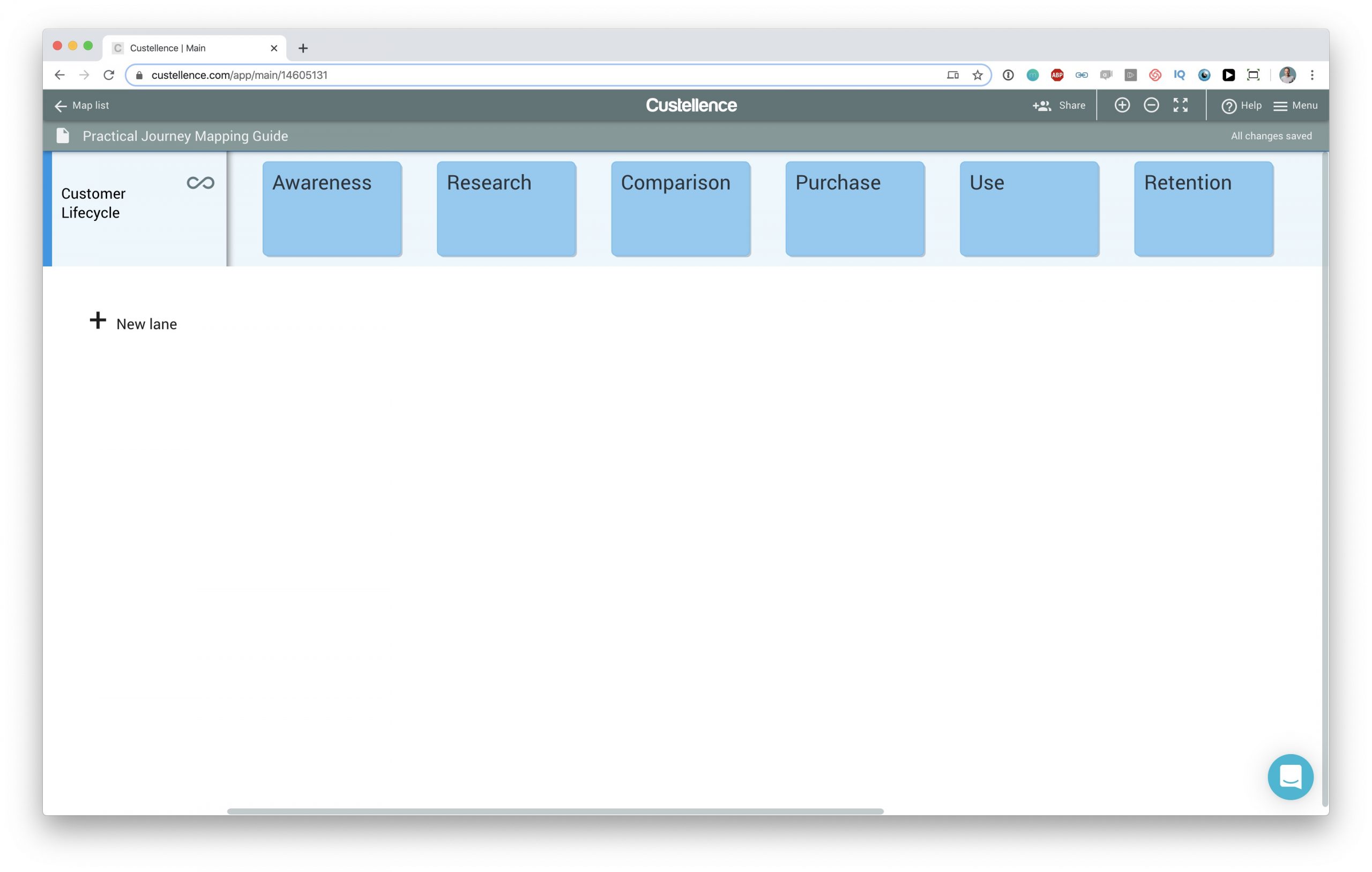
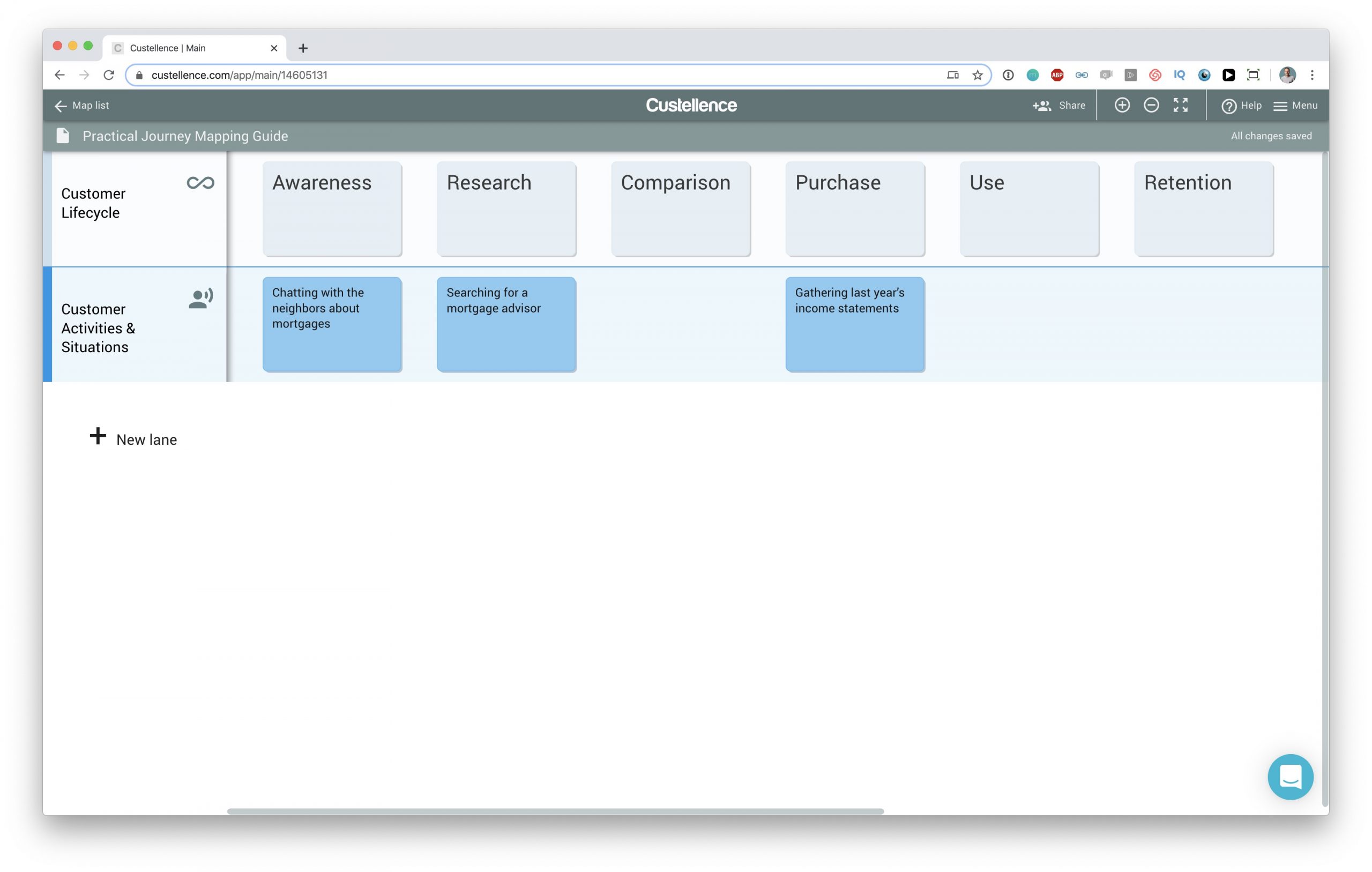
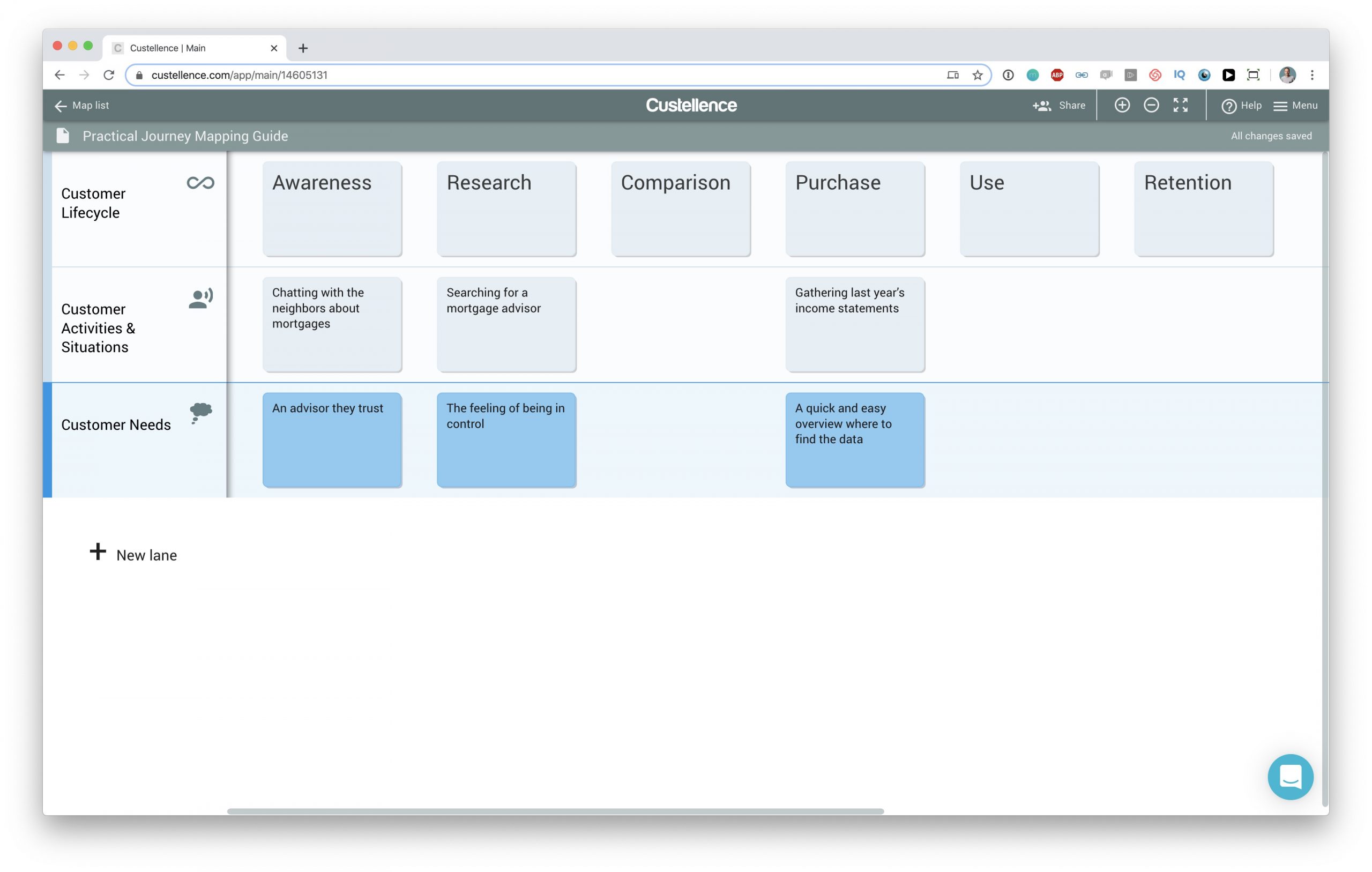
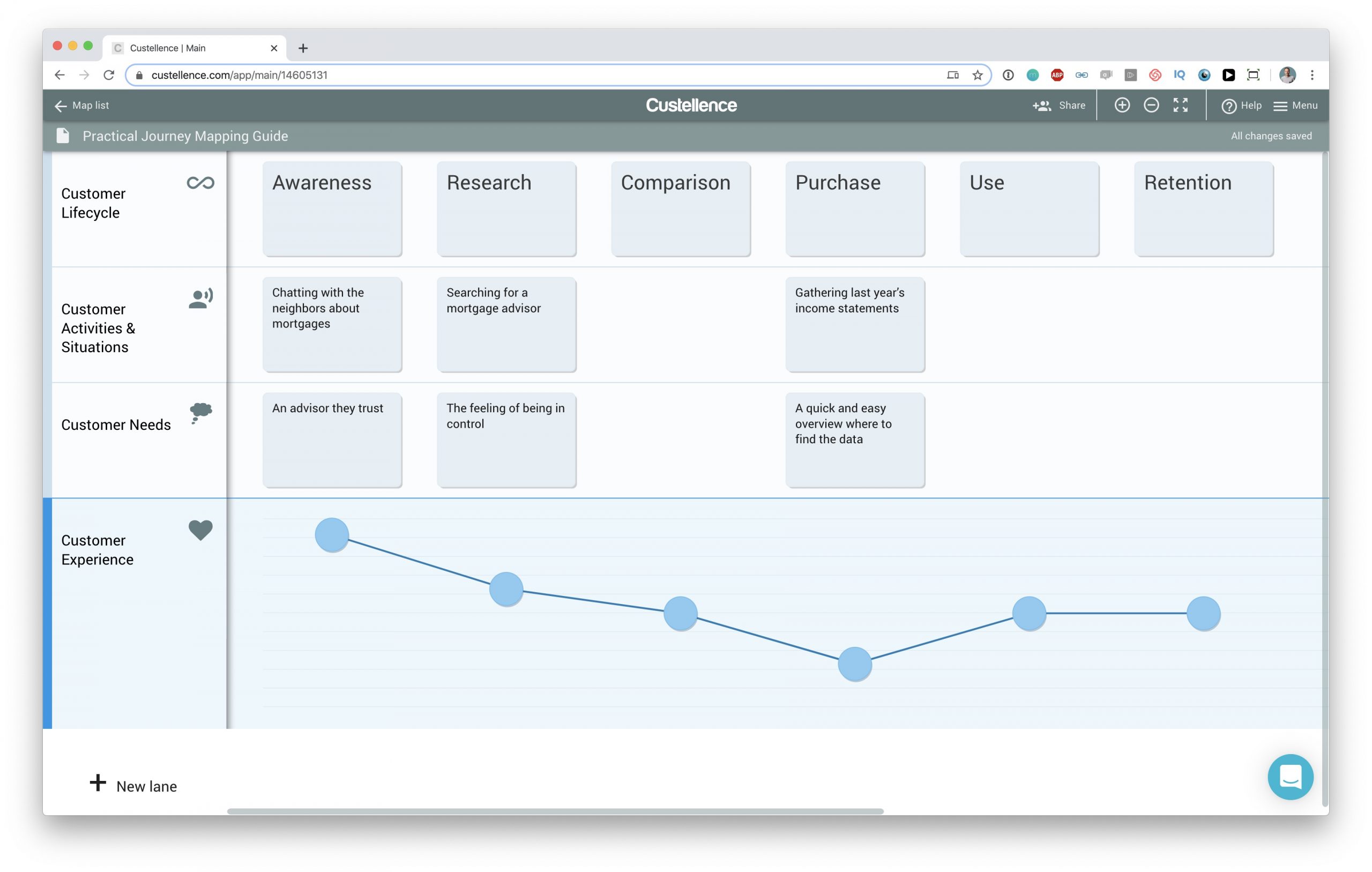
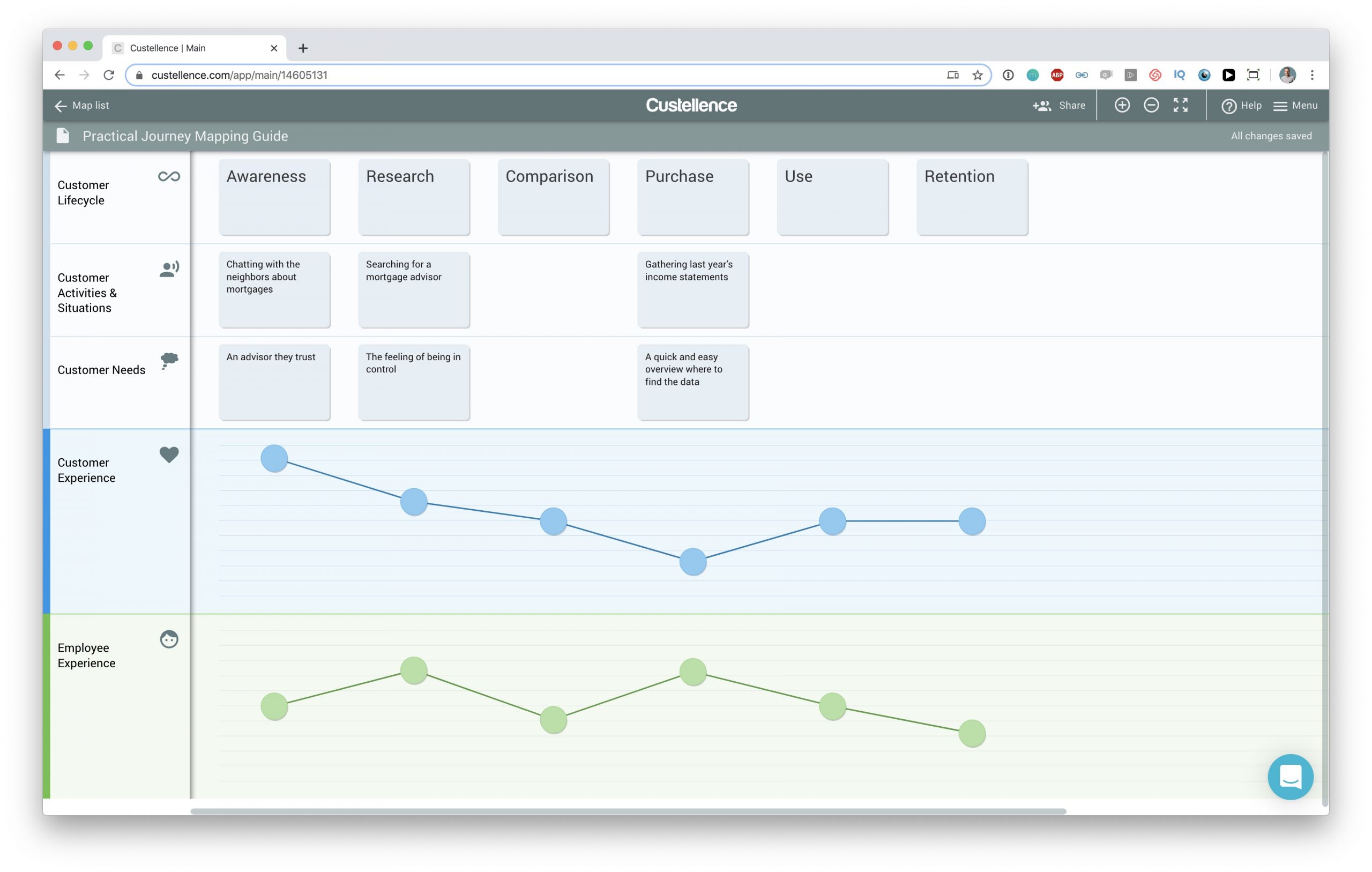
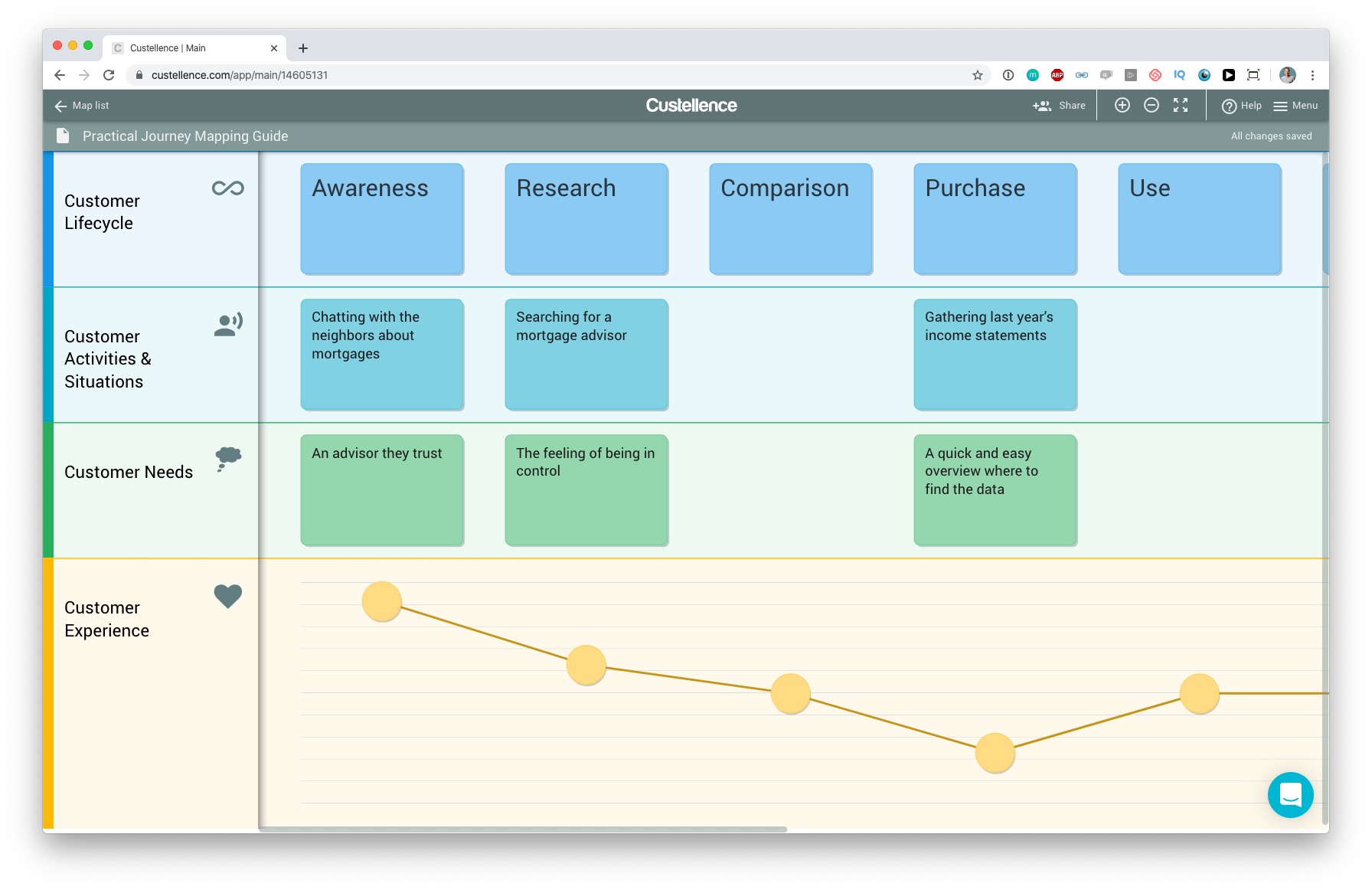
2 Replies
That’s a really great Overview. Thank you for going in depth here.
This is such a rich and detailed overview! Thanks!